














Jorge Hernández was just 14 when he and his younger brothers left their hometown of Rosa Morada in Sinaloa, Mexico, to pursue a music career in the United States. They hoped to settle in California, earn money to help support the family — Hernández’s father had been injured in an accident — and launch what would eventually become a music empire.
But first, the Hernández brothers would need a name for their aspiring musical act. They found it in an unexpected place.
“When we came to the United States for the first time, we didn’t have a name for the band — and the border agent who let us pass said we needed a name,” Hernández says, remembering that day in 1968. “He told us, ‘We call kids here ‘little tigers,’ but since you are going to grow up, and you are going north, you should be called the Tigers of the North.’

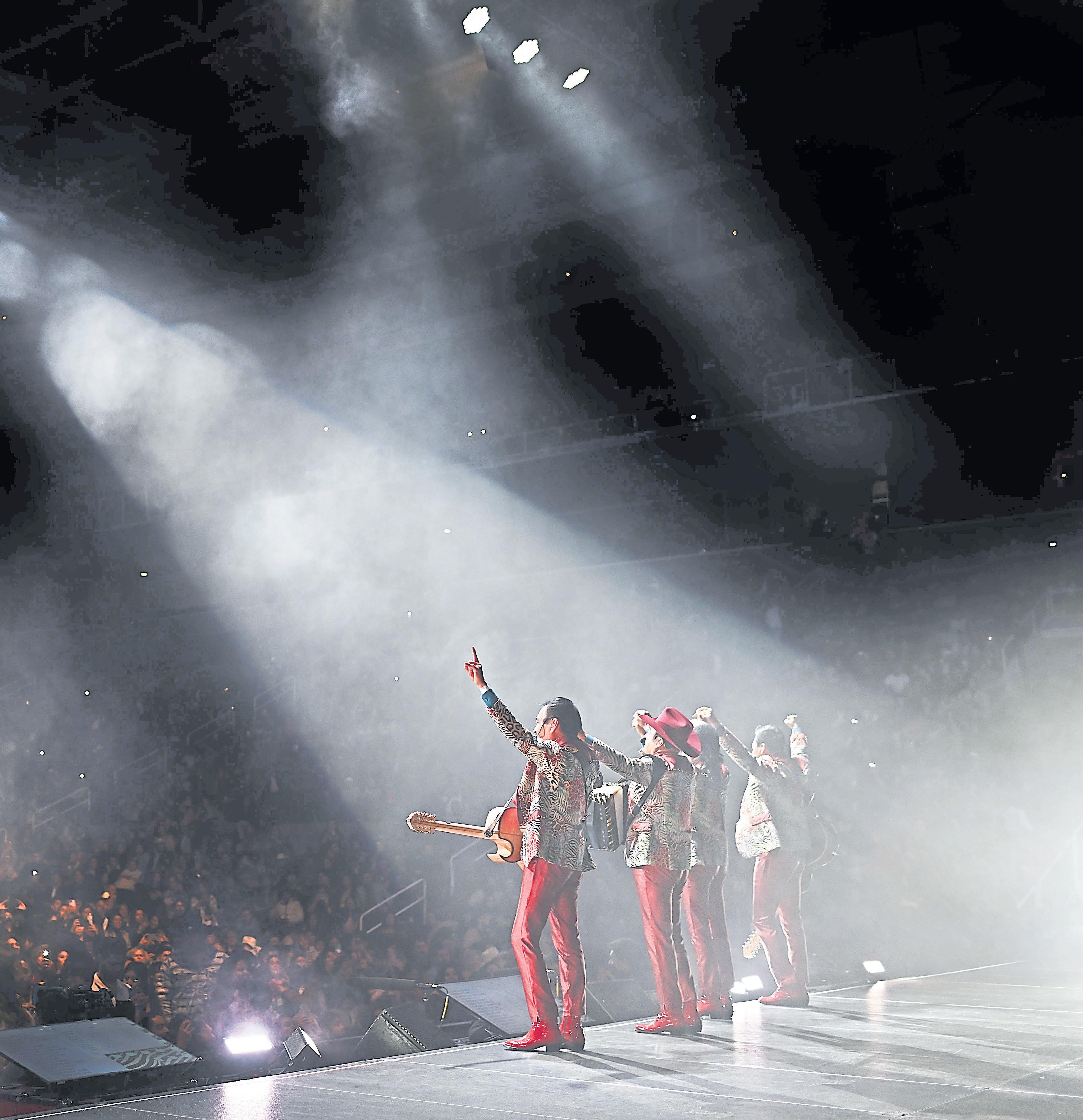

That is when we became known as Los Tigres del Norte.”
Today, it’s a name familiar to legions of fans on both sides of the border and around the world. Los Tigres del Norte has sold more than 40 million albums, won seven Grammy awards and a dozen Latin Grammys and has a star on the Hollywood Walk of Fame. The band routinely sells out stadiums and is considered one of the most popular regional Mexican music groups of all time.
“It’s great to have an iconic talent, Los Tigres del Norte, call San Jose home,” says James Hamnett, senior director of booking and events at San Jose’s SAP Center, a venue the band has played multiple times. “Over the course of their illustrious career, Los Tigres del Norte has continued to deliver memorable performances that have entertained the greater Hispanic audience while serving as a tre-
mendous community advocate throughout the Latin culture.”
Some might wonder why the band originally set up shop in San Jose, as opposed to a city like Los Angeles, with its deeper connections to the music industry. As Hernández explains, it had a lot to do with necessity.
“After a traveling caravan we were part of left us here in San Jose,” he says, “we had to make connections with folks in the local Latino community who took us in. From there, we began to work and go to school and plant roots in San Jose.”
With its deep roots in Mexican culture, the city turned out to be the right place for the young Hernández brothers to hone their craft — and get noticed by Arturo Walker, who signed Los Tigres to his San Jose-based record label, Discos Fama.
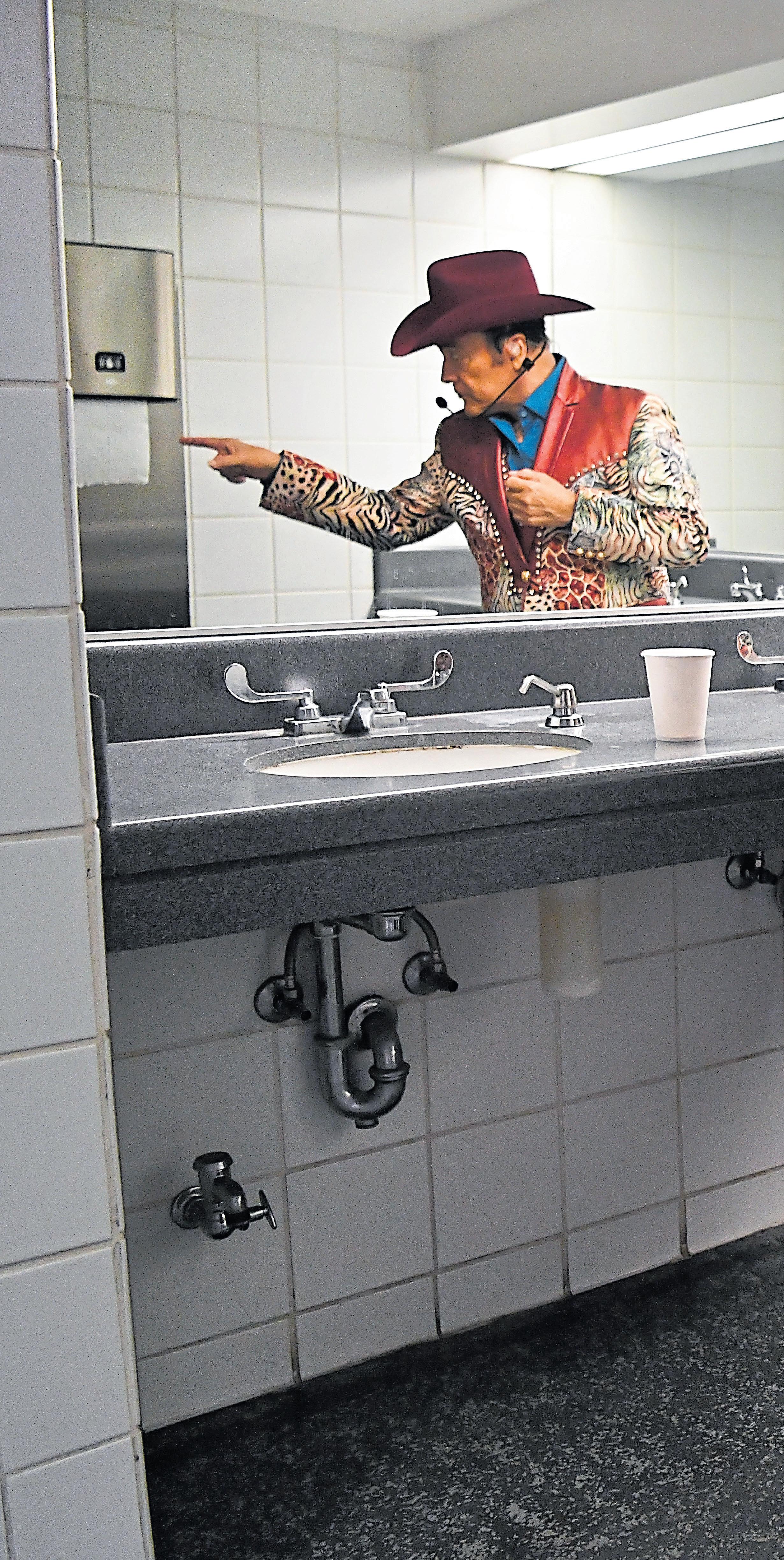

It didn’t take long for the young norteño band to achieve some success on a local level. But widespread fame arrived when Los Tigres del Norte recorded “Contrabando y traición” in 1974.
“As we started to record and work with Arturo Walker — Arturo Caminante, as we would call him — he and I thought that we needed to try something new and record a story that would get people’s interest,” Hernández says. “Once we recorded ‘Contrabando y traicion,’ we knew we had something special.”
“Contrabando y traición” — which translates to “Contraband and Betrayal” — is a corrido, a Mexican narrative ballad form that often deals with such topics as oppression, drug trafficking, crime and social concerns.
“For us, corridos are a part of our culture. They are the way our history has been passed down from generation to generation,” Hernández says. “We like to think of them as stories of our people and significant events that shape our society — all in a span of three and a half minutes. They tell our truths in a lyrical way that connects listeners with the songs and with one another.”
This particular corrido, written by Ángel González a few years prior to the Los Tigres recording, is a tragic love story set

Audience members, above, show their excitement after being acknowledged by Los Tigres del Norte lead vocalist Jorge Hernández, right, from the stage.

against a backdrop of international drug trafficking.
Los Tigres’ version, used as the title track on the band’s 1974 album, proved so incredibly popular, it not only helped chart the course going forward for the band, but it revived interest in the corridos art form. It also greatly helped popularize the narcocorrido (drug ballad) subgenre, which has millions of fans in both Mexico and the U.S., by delivering such fan favorites as “Muerte Anunciada,” about the infamous Colombian drug lord, Pablo Escobar.
“I like to say that (‘Contrabando y traición’) is the song that put us on the map, not only here but in Mexico as well,” Hernández says. “It gave us the confidence to keep going. It is now the foundation of what we
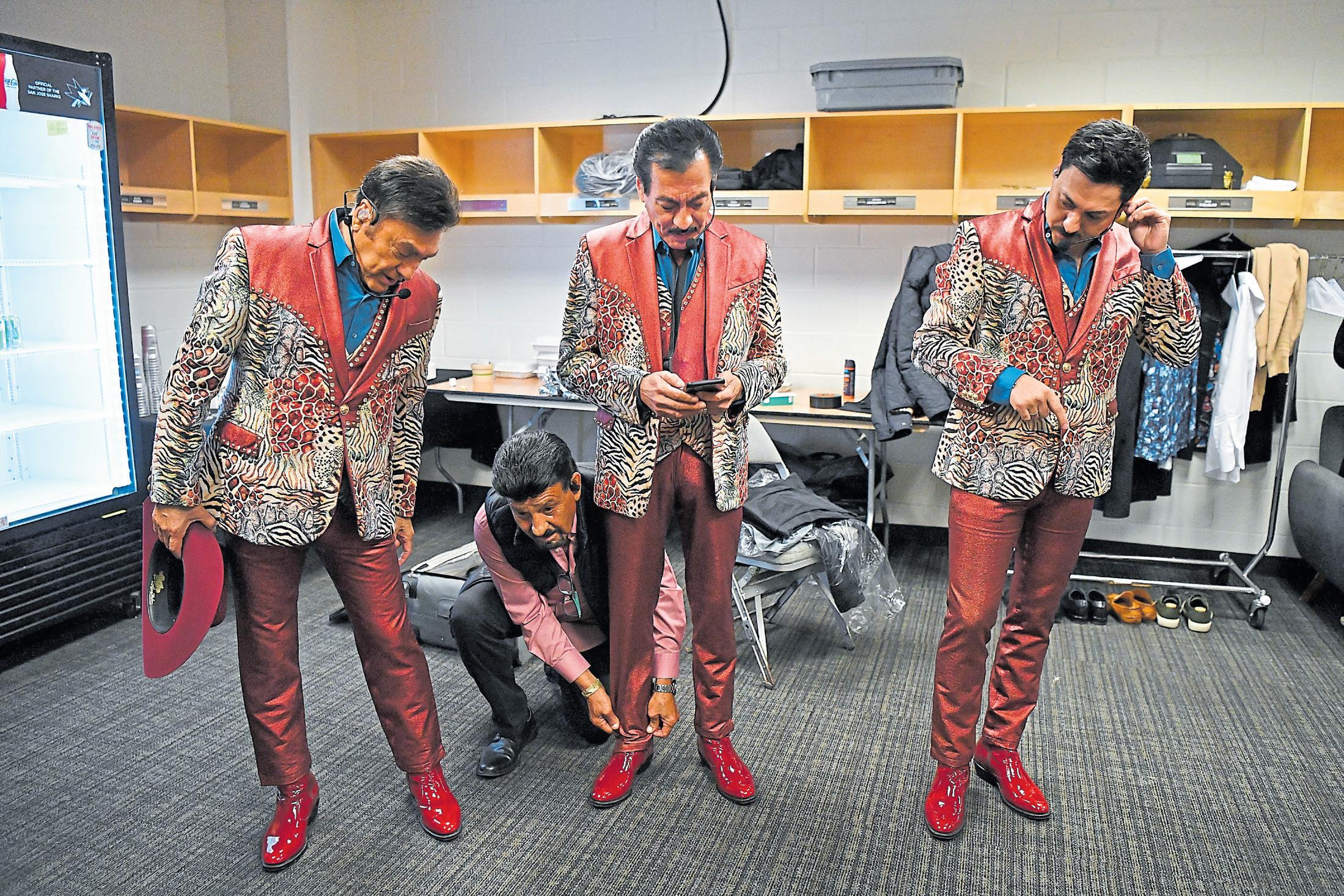
have become. (It’s) a corrido that has remained relevant and allowed us to continue to grow as a group.”
Heralded as a voice of the immigrant community, Los Tigres found much success through the ’70s and ’80s, winning its first Grammy in 1988 in the best Mexican/Mexican-American album category for “Gracias!... América...Sin Fronteras.”
“We see the immigrant community as our community,” Hernández says. “We are immigrants, and it means everything to us. We use our voice to continue to tell their story in a way that it can be heard across borders. Music and song are a
universal language, and we hope that the stories we tell will be heard more and more.”
They put their money on the line for that community, too. Los Tigres’ nonprofit foundation has given UCLA’s Chicano Studies Research Center $500,000 to preserve Mexican and Mexican-American culture and digitize 32,000 Spanish-language recordings, and the band donated proceeds from last spring’s SAP Center show to help Bay Area farmworkers.
But it’s the music that has the most profound effects. The band members — which currently include Jorge Hernández on lead vocals and accordion, Hernán Hernández on electric bass and vocals, Eduardo Hernández on accordion, saxophone, bass and vocals, Luis Hernández on bass
Los Tigres del Norte members Jorge Hernández, from left, Eduardo Hernández, and Luis Hernández prep in their dressing room backstage as assistant Willie Alvarez makes final adjustments to their costumes before the concert.
and vocals and Oscar Lara on drums — often hear fans talk about how much the group’s music has impacted their lives.
“We have so many memories and encounters with our fans almost daily,” Hernandez says. “We are so honored and humbled when they tell us that we have been with them, supporting them through the most difficult and happiest moments of their lives. Knowing that they heard their stories in our songs is what drives us to continue to being there for them.”
Los Tigres’ success isn’t just reflected by the number of awards in its trophy case but by the strength and loyalty of its fan base.
“I believe we are most proud of our fans,” Hernandez says. “We have had the opportunity
to be their voice for generations, and it is a great thing to see our music grow with our young audience, as their parents and grandparents show them how our songs relate to them and their stories.”
Last year, Latin music eclipsed country music in popularity for the first time, according to Billboard, and the audience goes far beyond Latinos. Latin music has grown into a multicultural, global juggernaut, appealing to both Spanish and non-Spanish-speaking audiences, thanks in large part to Los Tigres’ role in helping shape and popularize the music form.
It’s not hard to draw a direct line between the music of Los Tigres and, for example, that of red-hot newcomer Peso Pluma, who was one of two Latin music artists (and Bad Bunny the other) to make Spotify’s list of the top five most-streamed artists of 2023.
Hernández says the band feels very honored when members hear these newer artists say they’ve been influenced by Los Tigres del Norte.
“It is very high praise for us and humbling when younger artists tell us that we inspired them to create music and tell their story in a similar way to ours,” he says. “We have a lot of respect for the younger generation of artists. They have created a new wave for our genre, and we wish them all continued success.”
After more than half a century of rocking with San Jose’s legendary Doobie Brothers, Tom Johnston still sounds great on the microphone.
“Practice,” Johnston says from his home in Marin County. “To me, that’s the key to it. I don’t mean only when you are rehearsing to go on a tour. You’ve got to do it when you are off, too. You’ve just got to keep your voice in shape. It’s a muscle like anything else, and if you let it atrophy, then it’s really hard to bring it back.”
Johnston is getting ready to showcase those vocals once again. The Doobies will hit the road later this year for a 38city national tour that includes Northern California stops at Wheatland’s Toyota Amphitheatre on June 20 and Concord Pavilion on June 22.
The 75-year-old vocalist and guitarist credits the band’s road work as vital to its longevity. “Touring a lot is one of the big
(things) that keep everyone aware that you are around,” he says. “That’s one of the things that keep us going.”
Beyond a full slate of gigs, the Doobies also plan to release a new album this year, the band’s second studio album in roughly three years. Many of the Doobies’ contemporaries have pretty much stopped putting out new albums, but Johnston says it’s important for the Doobies to keep recording.
“It keeps the band fresh,” he says. “You play new stuff in the live show, and the crowd likes it. I mean, it’s not going to be something that they are ready to sing along with like one of the big hits. But — who knows? — maybe it could end up being one.”
The Doobies have more than a fair share of big hits, including such gems as “China Grove,”
“Takin’ It to the Streets,” “Listen to the Music,” “Black Water,” “Rockin’ Down the Highway” and “Jesus Is Just Alright.” Those songs remain staples

on classic rock radio many decades later. Even Johnston can’t tell you what it is about these songs that continues to charm both old and new listeners.
“I wish I could tell you what that is. We are extremely fortunate,” he says. “The songs strike a chord with people, both rhythmically and lyrically, and they like singing along with whatever the chorus is.”
Johnston has certainly witnessed massive crowd singalongs whenever the Doobies — Johnston, vocalist-guitarist Patrick Simmons, vocalist-keyboardist Michael McDonald, multi-instrumentalist John McFee and several touring members — unleash the greatest hits in concert.
“People always know those songs,” he says. “They always stand up, singing them back to you, and it’s amazing. There are just a lot of songs that fit in that mold. We are very lucky. It’s not something where you sit down and say, ‘I’m going to write a hit that everybody is going to love 50 years from now.’ That’s not the way it works. It’s that you happen to walk in the right door.”
Johnston definitely walked in the right door when he first left home in Visalia in 1968 to study graphic design at San Jose State. He laid the foundation for his music career at his first home here. That house at 285 S. 12th St. is now a historic landmark.
“Other musicians were over there all the time. We were always jamming in the basement,” Johnston says. “It was kind of a music center for San Jose — a great place to be at that age at that time.”
One of his roommates was John Hartman, who became

the Doobies’ original drummer.
The two met Patrick Simmons, a graduate of San Jose’s Leigh High School, who certainly knew his way around the guitar.
“John and I watched him play with a band he was in — it was an acoustic thing — and we were kind of blown away,” Johnston remembers. “We thought he was a really great guitarist. He sang, and that was a plus. So, we asked him to come over and jam.”
Eventually, the jam turned into a band and with the addition of bassist Dave Shogren, the Doobie Brothers were born. The
group began gigging around the area and soon drew the interest of Warner Bros., which signed the Doobies to a deal. The band’s self-titled debut came out in the spring of 1971.
“It was all just — for lack of a better way of putting it — magical. It just kind of happened,” Johnston says. “The first album didn’t do a lot. The second album (1972’s ‘Toulouse Street’) took off with ‘Listen to the Music.’ And it just kept going.”
They hit double-platinum status with the back-to-back releases of “The Captain and Me” (1973) and “What Were
and John McFee of The Doobie Brothers perform live onstage at iHeartRadio ICONS with The Doobie Brothers at iHeartRadio Theater in Burbank on October 1, 2021.
Once Vices Are Now Habits” (1974), then saw their fortunes zoom even higher with the triple-platinum success of 1978’s “Minute by Minute.” Along the way, they’d showcase a variety of styles and genres in their music.
“We were an eclectic bunch,” Johnston says. “We all had rock ’n’ roll roots, but Pat was into finger-picking and guys like Doc Watson. I was more R&B as well as the blues. So, we mixed that all together, if you will. We just wrote songs, and they came out sounding the way they sound, because you’d have those various influences on each tune, and it
just sort of happened.”
The Doobies were finally inducted into the Rock and Roll Hall of Fame in 2020. The nod came after years of eligibility and much debate among fans as to whether the Doobies would someday get the call. Yet, the band members never really joined that discussion.
“We didn’t ever sit around and talk about it a lot,” Johnston says. “In fact, we didn’t really talk about it at all. Occasionally, it would get batted around with management. But we most always kept our head down and kept working.”
Long ago, Bay Area residents left their homes to be entertained. Before TV, record players or even radio, the local concert hall was the place to see vaudeville or grand opera, popular touring bands, famous singers or silent movies accompanied by the music of a live organ.
By the early 1900s, nearly every Bay Area enclave had its own live performance space. Some of these venues felt like small palaces, as splendid as the finest big-city opera house. Others began as neighborhood clubs or community halls, before evolving into beloved destinations for arts and culture.
Several of these historic theaters are still thriving, the pride of their Main Streets, even if the nature of the entertainment has changed. They also serve as a reminder that, even in this siloed, streaming age, people still want to come together and see a show in an inviting place. Here are nine gems.
San Jose
She’s the grande dame of San Jose’s cultural scene, a 1927 star who experienced many fallow years later in the century before returning to prominence, her neon “CALIFORNIA” sign again towering over downtown’s South First Street.
The opulent 1,100-seat theater is the home of Opera San Jose and the Symphony San Jose and plays host annually to the Cinequest Film
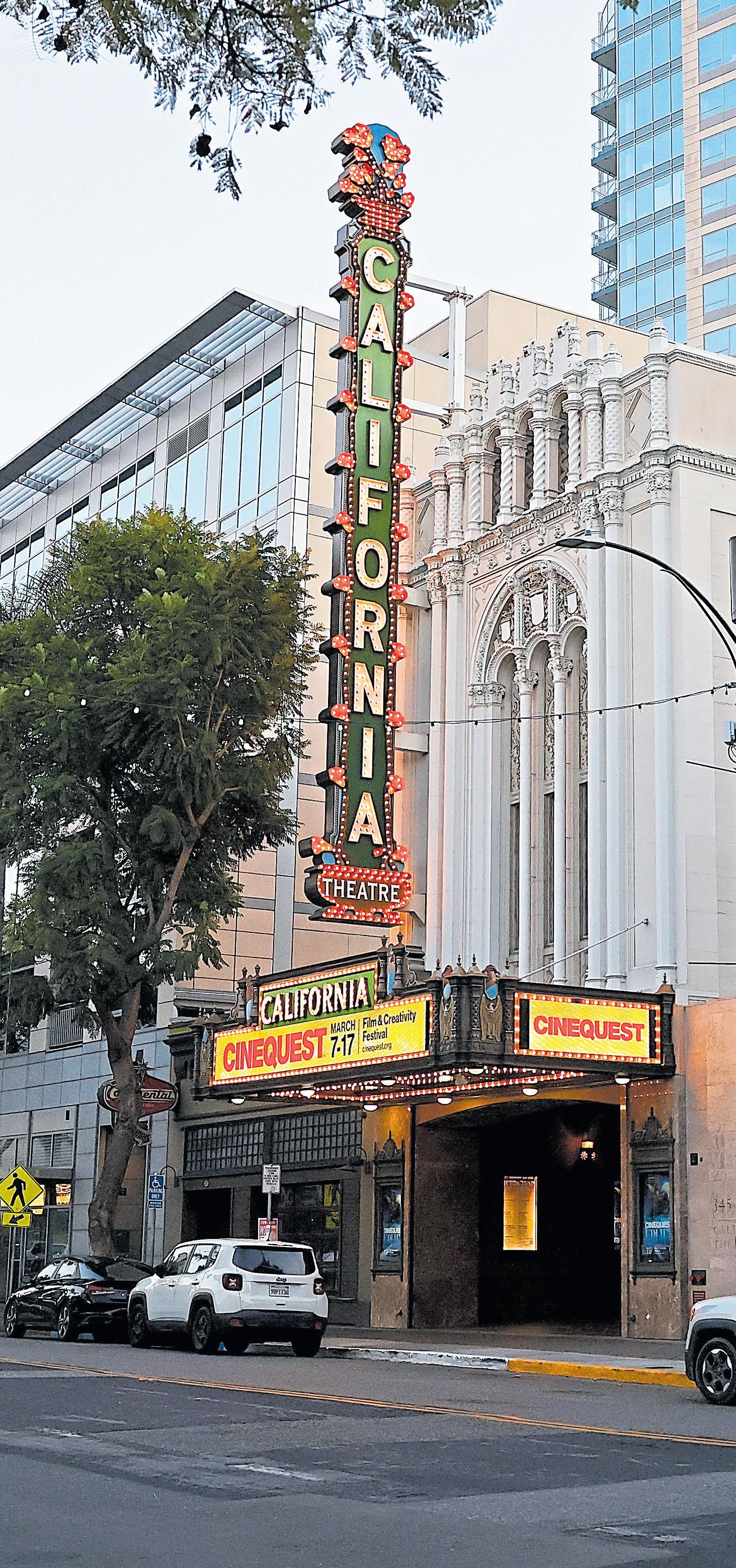

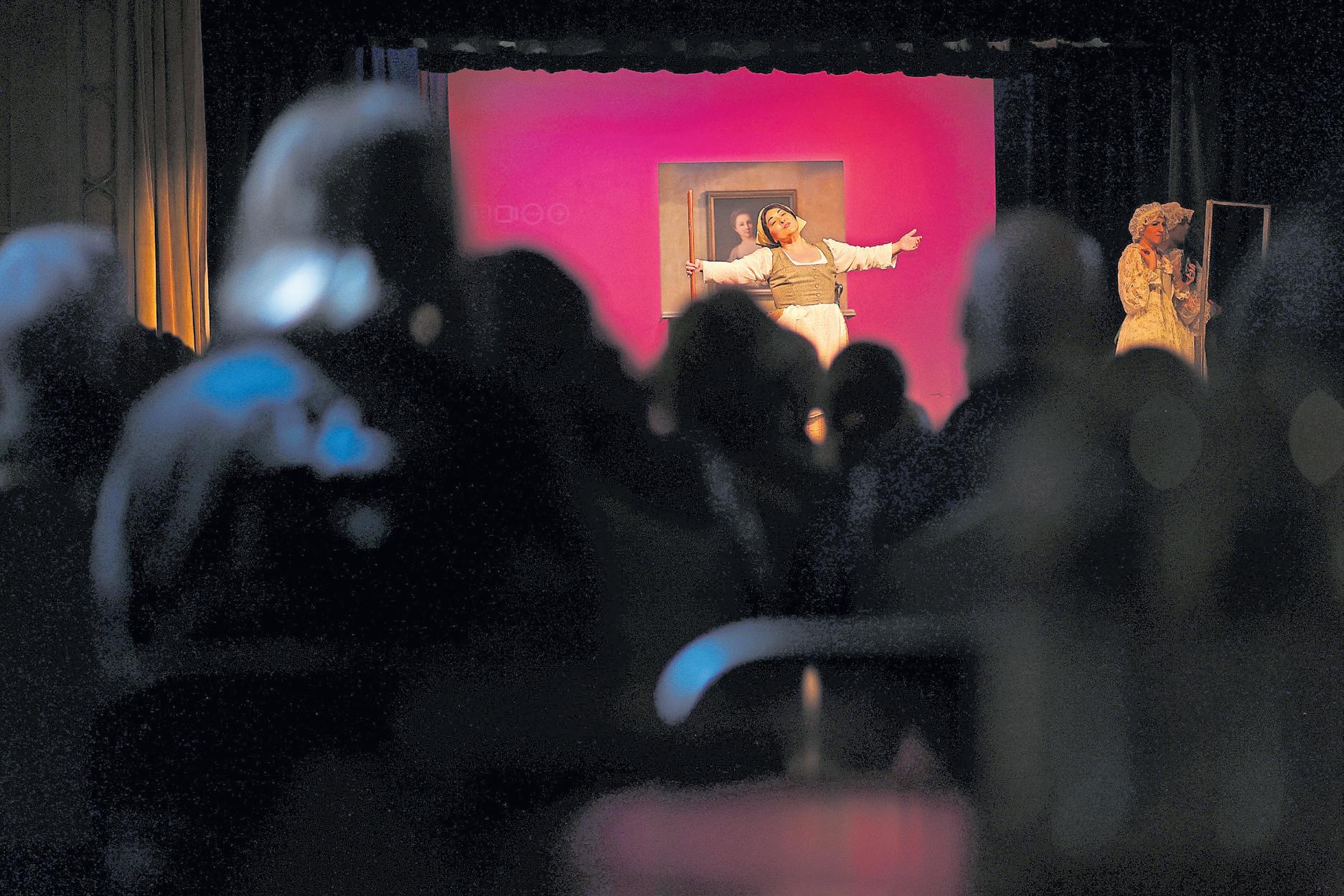
Festival, with organist Dennis James playing silent film scores on the mighty Wurlitzer.
That the building was restored to its original magnificence is an almost unbelievable story. The California languished for nearly three decades after its closure in 1973. The San Jose Redevelopment Agency purchased the site in 1985 but struggled for years to find funding for the massive project. In the end, the property tax-funded agency paid two-thirds of the $75 million
tab, and philanthropist David Packard contributed one-third through his Packard Humanities Institute, along with his personal design oversight.
The three-year renovation culminated in a grand reopening in 2004. Opera San Jose, founded by globally renowned opera singer Irene Dalis, who had watched movies here as a child, presented Mozart’s “The Marriage of Figaro.”
Kudos for the gorgeous renovation came from all corners.
Calling it a “masterpiece,” a Mercury News editorial noted, “The California brings new hope to downtown.” Alan Hess, who wrote architectural reviews for the paper, raved about the painstaking attention to the Spanish Renaissance facade, the “ingenious” interior design work by Berkeley architects ELS and their “sensitivity to the original aesthetic.”
“All this effort was bestowed on the right structure,” Hess wrote. “In 1927, this movie and
vaudeville theater by architects Weeks and Day rivaled anything found in San Francisco and much of Los Angeles. These grand movie palaces inspired by the relatively new technology of the movies offered the average citizen an evening in a palace.”
Now nearly a century old, the California offers that palatial experience scores of nights a year.
Shows coming up: Opera San Jose’s first Spanish language work, the Bay Area premiere of Mexican composer Daniel Catan’s “Florencia en el Amazonas,” April 28-May 5; Symphony San Jose’s “Passionate Puccini,” May 11-12; and Sofia Niño de Rivera, a noted Mexican stand-up comedian and actress, May 17. https://sanjosetheaters.org
After these neighboring East Contra Costa County cities transitioned from Delta farming communities to thriving centers of industry, enterprising locals worked to bring culture to their booming downtowns.
In Pittsburg in 1920, local entertainment moguls Sylvester and Salvatore Enea opened the California Theatre, one of several they would go on to operate in the area. They promoted the theater as a premiere venue for vaudeville shows and silent films, with architect A.W. Cornelius designing the theater in the classical revival style, fronted with sculptures and Corinthian columns.
Eight years later, a news report announced that “the most pretentious building in Contra Costa County” had opened in Antioch. Perhaps that was a compliment in the Roaring ’20s, because El Campanil is notable for the elegance of its ornate

Spanish Colonial facade, topped by a bell tower for which it was named. El Campanil owners Ferdinand Stamm and Ralph Beede booked touring vaudeville acts and silent films for the new venue.
Early patrons at both theaters paid just 25 cents for general admission, and they still enjoyed an elegant night out in the plush seats of auditoriums graced with elaborate murals and chandeliers. Over the decades, the theaters also brought popular
Built nearly a century ago, Littlefield Concert Hall on the former Mills College campus features bold, colorful murals and richly ornamental ceiling decor.
national touring acts to East Contra Costa, with El Campanil playing host to Mary Pickford, Roy Rogers and Donald O’Connor. El Campanil also found a unique way to track its history. Anyone who performed on its stage was invited to leave their autograph on a wall in the green room or men’s and ladies’ dressing rooms.
Over time, the theaters began to struggle, due to evolving tastes in entertainment and the changing fortunes of down-
towns. The California showed its last movie in 1954 and subsequently fell into disrepair. El Campanil hung in longer. But at one point, it was used by a church group that supposedly so objected to holding services on a stage beneath a mural depicting two nude women that the artwork was painted over.
Near the turn of the 21st century, city leaders and arts lovers in both cities realized that putting their historic theaters back to work could bring

residents back downtown. Each town raised millions to rehab pipe organs and refurbish light fixtures and decor, restoring a mural of two winged nymphs dancing alongside the stage at the California Theatre and the two nudes who caused such a fuss at El Campanil. The Antioch and Pittsburg theaters reopened in 2004 and 2014, respectively, and have staged hundreds of concerts, plays, comedy acts and community events each year since.
And those backstage autographs can still be seen at El Campanil, including a signature by Debbie Reynolds, who performed at El Campanil’s gala reopening.
Shows coming up: At El Campanil, catch ZZ Tush’s tribute to ZZ Top on May 3; Forejour, the Foreigner and Journey tribute band, on May 25; and “The ‘Phantom’ Returns: Franc D’Ambrosio in Concert” on June 9; www. elcampaniltheatre.com. At the California Theatre, Pittsburg Theatre Company’s “Willy Wonka” hits the stage on May 4; https://pittsburgcaliforniatheatre.com.
This concert hall is a recent success story, one that gladdens the hearts of preservationists and longtime Peninsula residents when they drive by on El Camino Real — particularly because a nearby vintage theater, the Park, was demolished a decade ago.
The eldest of the two, this theater was called the Menlo when it made its debut in May 1926. Designed in the Streamline Moderne style of the day, the theater hosted burlesque shows and showed movies in the early years, according to the Cinema Treasures website.
In March 1948, the Menlo reopened for movies only as the Guild, with David Lean’s adaptation of playwright Noel Coward’s “This Happy Breed” christening the big screen. Articles and ads in the the Palo Alto Times trumpeted the “abstract” decor, a live flower garden in the foyer and state-of-the-art projection and sound systems. “It will be operated strictly for the pleasure of those who enjoy only the finest in film fare, and for those who have lost interest in the usual run of pictures,” the own-
ers said. “The Guild will be the foreign-language headquarters, theatrically, on the Peninsula.”
And for decades that was the case, with independent and foreign language films playing here along with top motion pictures until 2019, when the theater’s 93-year run came to an end.
The Peninsula Arts Guild had already entered the picture. This nonprofit with a mission to develop a live-music venue in 650 land embarked on an ambitious, $35 million renovation that includes some vintage art deco pieces.
The Guild reopened in 2022 — again, state of the art — to feature both “little bitty bands that nobody has heard of” and “stadium acts” for 500 audience members, the group’s president, Drew Dunlevie, said at the time.
The theater is heavily booked and drawing well. “We did 174 shows/events in 2023, and we’re looking at 200-plus in 2024,” general manager Tom Bailey said.
Shows coming up: Grahame Lesh & Friends with special guest Stu Allen, May 3; Susto Stringband, May 17; Stephen Marley, May 27; Ryan Adams, June 7 and 8; www.guildtheatre.com
Oakland
Built in 1928, Littlefield Concert Hall swiftly became “ground zero” for 20th-century music innovation, a place where “the future of music arrived first,” according to one music critic.
Over its nearly 100-year history, the hall hosted performances for a music department with an outsize influence on contemporary music. Its faculty and students pioneered new sounds

The dressing room walls at Antioch’s El Campanil Theatre are covered with the autographs of nearly a century’s worth of actors, including Debbie Reynolds, whose signature is protected by a sheet of plexiglass.
JOSE CARLOS FAJARDO/STAFFand practices in classical music, jazz, electronic music and more with artists including Darius Milhaud, Henry Cowell, Lou Harrison, John Cage, Pauline Oliveros, Maggi Payne, Dave Brubeck, Laurie Anderson and Roscoe Mitchell. And the hall hosted historic performances by such luminaries as Igor Stravinsky, Nadia Boulanger and the Pro Arte, Budapest and Kronos string quartets.
The gracious Spanish Colonial facade and entrance framed by medieval, Renaissance and Baroque statuary introduce visitors to the eclectic vision of English-born architect Walter Ratcliff Jr. Inside the 450-seat auditorium, Depression-era painter Raymond Boynton created boldly colorful ornamental ceilings and fantastical murals and frescoes inspired by ancient mythology, musical motifs, California history and the
state’s natural beauty. Boynton said his goal was “to give free play to the imagination and, through color and rhythm and formality, heighten that mood in the listener.” David Bernstein, the former music department head, called the hall the “visual embodiment of the spirit of the experimentalism” that was cultivated at Mills.
During an extensive 18-month renovation in the late 2000s, old and damaged wall tiles were replaced with elegant new acoustic panels that enhanced the hall’s sound. Mills’ music department closed after financial challenges forced the campus to merge with Boston-based Northeastern University in 2022. Bernstein said it’s not certain what the future holds, but Littlefield Hall still hosts a concert series that allows people to experience music in a beautiful, uplifting setting.
Upcoming shows: Find concert listings at https://performingarts.mills.edu.
Students who attended Campbell Union High School decades ago performed on the stage of what had to have been one of the most impressive school auditoriums in the state, if not the country.
Now restored as a concert hall, the auditorium and two other campus buildings are considered rare examples of Spanish Colonial Revival style architecture constructed by the 1930s Works Progress Administration, the New Deal program that employed Americans to build public works projects.
Credit goes to noted (and

prolific) California architect
William H. Weeks, who designed hundreds of banks, schools and Carnegie libraries throughout the state — along with the Cocoanut Grove in Santa Cruz and the De Anza Hotel in San Jose — in the early decades of the 20th century.
The high school closed in 1980, and the site was turned over to the city. “The theater was shut down in 1982 due to structural concerns, and the once-great cultural resource was ‘dark’ for 20 years,” a city
The Lafayette Town Hall Theatre served as a church, a meeting hall and even military housing before becoming a performing arts venue.
RAY CHAVEZ/STAFFhistory said. Demolition of the 1938 building was in the works, until a group of citizens rallied, formed the Friends of the Heritage Theatre, incorporated in 1998 and set about raising renovation funds.
In 2004, the refurbished and renamed Campbell Heritage Theatre — “Campbell’s crown jewel” — was reintroduced to the South Bay at a champagne gala featuring entertainer Tommy Tune and the Manhattan Rhythm Kings.
Today, the Heritage hosts events year-round. And the friends group is still around to ensure that it remains a state-ofthe-art venue.
Shows coming up: Mavis Staples’ 20th anniversary show, May 10; “Sleeping Beauty” by the Academy of Classical Ballet, May 18-19; Peninsula Symphony Orchestra with pianist Jon Kimura Parker, May 24; “Late Nite Catechism,” June 9; Benise Fiesta, Oct. 6; Nick Carter, Nov. 22. www.campbellca. gov/353/Heritage-Theatre
Berkeley
On a rainy February evening, guitarist Bruce Victor and mandolinist Marla Fibish finish a preshow sound check for Noctambule, a duo that performs traditional Irish music and their own songs. Their voices carry like bells through an auditorium known for its acoustic resonance and unique setting.
The Hillside Club began as a private social club for women in the late 1800s. The clubhouse was built in 1906 after membership expanded to include prominent local men, including architect Bernard Maybeck, who designed the building in his signature Arts and Crafts aesthetic. But 17 years later, a devastating fire swept out of Wildcat Canyon and destroyed the clubhouse and more than 600 other structures north of the UC Berkeley campus, including Maybeck’s home. The overwhelmed architect told the club to ask his brother-in-law and acolyte John White to design the clubhouse replacement.
White kept the Arts and Crafts architecture but added an expanded stage and auditorium to reflect the club’s increased focus on the performing arts. Carved wooden beams and tall casement windows grace the interior, and a stained-glass window depicts a sunny coastal scene of redwoods, ocean and blue sky.
The club’s membership has waxed and waned over the decades, but new energy arrived in the 2000s, according to past president Jim Fisher. New members with eclectic artistic tastes as well as sound-technology expertise worked to make the club into what music critic Andrew Gilbert has called a “vital outpost” for local and regional musicians seeking to perform in intimate settings. The club hosts a regular slate
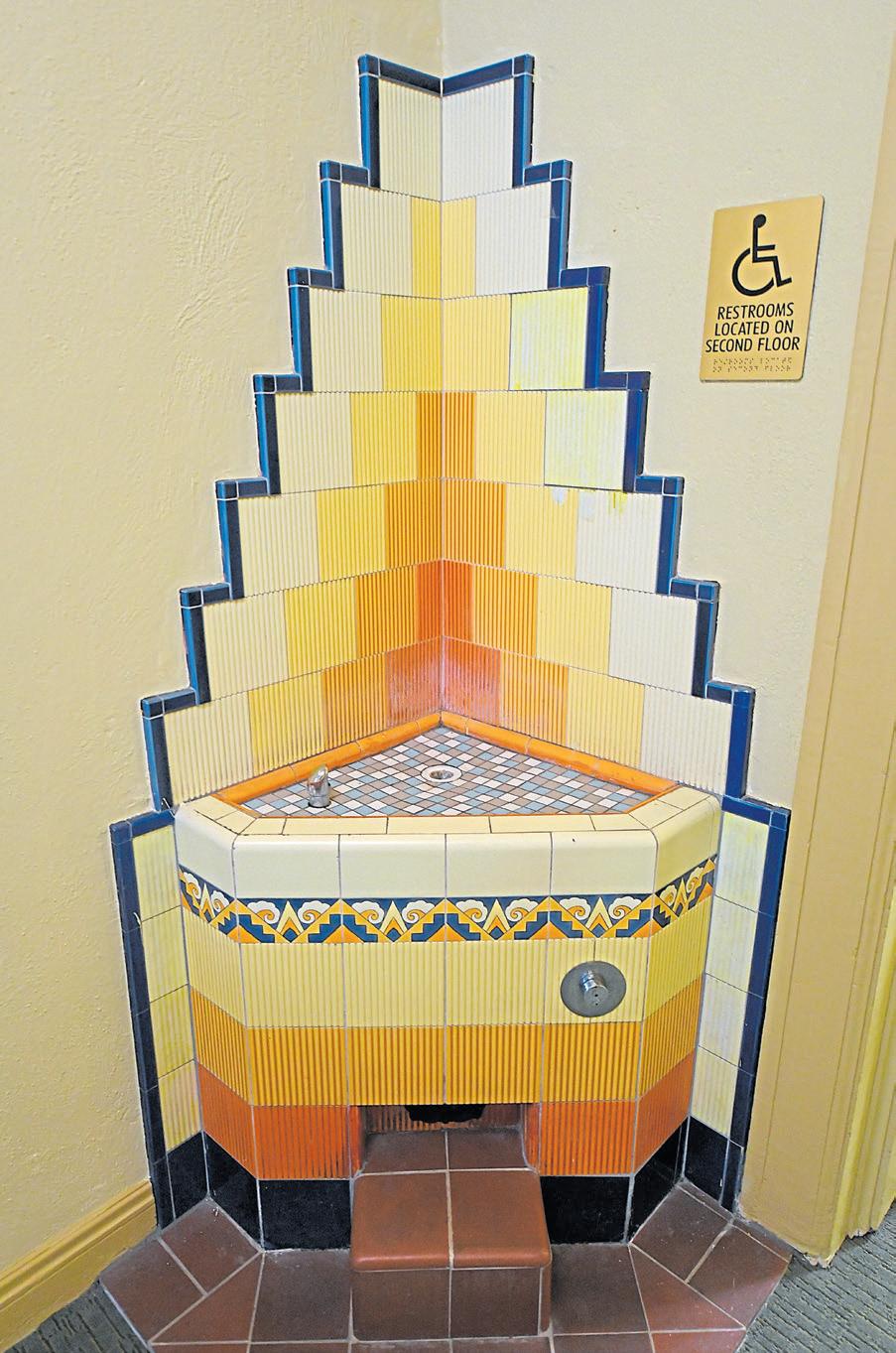
of classical, jazz and folk music as well as opera, including the Pocket Opera company’s recent chamber production of Rossini’s “La Cenerentola.”
Shows coming up: A Mother’s Day matinee of bluegrass and classical music by Tristan Scroggins and Alisa Rose May 12; www.hillsideclub.org.
Redwood City
Talk about impressive pedigrees. This concert hall set in the heart of downtown is part of the architectural legacy of the famed Reid & Reid company, formed by two brothers who moved from Indiana to the West Coast. They’re known for designing such landmarks as the Hotel del Coronado near San Diego (1888), San Francisco’s Fairmont Hotel (1907) and the 1909 itera-
tion of the Cliff House.
In the 1920s, they designed many Northern California movie theaters, among them the Alexandria and the Balboa in S.F., the Golden State in Monterey and the Grand Lake in Oakland.
And then Redwood City. This movie palace made its debut just after New Year’s in 1929 as the Sequoia Theatre but was purchased some months later by the Fox company, according to the theater’s website.
A four-month renovation took place in 1950, but there are vestiges from the 1920s. “Much of the interior is original, including the beautiful murals,” general manager Ernie Schmidt said. “We even have the working water fountain dating back to 1929.”
“Then, as now, we rely on the efforts of the community,” said Dennis Markam, the theater’s managing director. “We (just) had volunteers from the National Charity League here, helping us paint things and reorganize our backstage.”
Everything inside Pittsburg’s century-old California Theatre is richly adorned, even the water fountains. In its early days, the venue hosted live vaudeville performances and silent film screenings.
JOSE CARLOS FAJARDO/STAFFIn the years since live performances started, the Fox has hosted entertainers including Art Garfunkel, the Beach Boys, Air Supply, Merle Haggard and Tom Jones and comedians Joan Rivers, Dana Carvey and Jason Alexander and such luminaries as President Obama.
Shows coming up: Egyptian pop star Ahmad Saad, May 4; “One of Those Nights: The Songs of the Eagles,” May 11; Odette Quesada, 40th anniversary celebration concert, May 12; “The Concert of Kings,” June 22; ABBAMania and Night Fever, June 29; “The Sweet Caroline Tour” starring Jay White, Oct. 12. https://foxrwc.com/
For 110 years, this 185-seat theater has always been a community effort. Lafayette residents donated the land and $200 towards the costs of putting up the original shingled structure, and in the decades since, locals have come through with funds to bring the theater up to fire code and upgrade the stage, seats and lighting. Often, they do the labor themselves.
The theater was never an actual town hall, but it was always a nexus, providing space for whatever was needed in a mostly rural community. It hosted dances, meetings, church services, a library, a nursery school and even basketball games. It opened in 1914 in grand fashion with a ball that attracted hundreds of revelers from across the East Bay, who traveled to Lafayette by the old Oakland-Antioch & Eastern Railway. Because the dance started fashionably late at 9 p.m., a special train was brought in to transport people home in the early morning hours.
After the United States joined World War II, the hall briefly housed soldiers, according to Markam.
But the hall became a performing arts venue, and a theater troupe, the Dramateurs, began staging productions there.
The Dramateurs reorganized as the Town Hall Theatre Company in 1992 and has presented a season of around four plays every year since, save during lockdown in 2020.
The company, which took over building ownership in 2021, offers theater classes and welcomes other local arts groups. Among them: Front Porch Open Mic, a group of singers and musicians who organized front porch concerts of folks, bluegrass, country and blues during the pandemic. Now they do a regular slate of performances at Town Hall.
Shows coming up: “Yes, and Wine! Adult Improv” on May 19; www. townhalltheatre.com
The Bay Area’s vibrant acoustic music scene in the 1960s and 1970s helped make Berkeley’s Laurie Lewis, who grew up learning classical piano and violin, a bona fide bluegrass star and an inspiration to young local musicians who’ve followed in her footsteps.
Bluegrass festivals seeded fan communities far beyond rural Appalachia, where the string band musical style was popularized by Grand Ole Opry star Bill Monroe. But there was something about the Bay Area that made it easy for someone like Lewis, with no background in a musical style mostly performed by men, to fit right in.
“It wasn’t until I started touring nationally that I realized what an oasis this place was and what a good place for me to get into the music, because it was completely acceptable,” Lewis recalled over coffee at Way Station Brew, one of her favorite Berkeley cafes. “If you loved the music, you should play it.”
As an “older statesperson” of the Bay Area bluegrass and roots music scene now, Lewis can point to a number of local musicians who’ve followed in her footsteps, many of whom she’s helped along the way, and signs that the region continues to provide opportunities for budding traditional musicians.
Two of bluegrass’ biggest new stars are Bay Area women — Molly Tuttle and AJ Lee. San Francisco’s free Hardly Strictly Bluegrass Festival, now in its 23rd year, showcases the music not often heard on commercial radio. And new young talent like the East Bay’s Crying Uncle, who hone their skills at local and regional music festivals, cafes, farmers markets and other venues, are driving interest among the region’s kids.
But Lewis also worries the region’s astronomical cost of living makes it much harder to make it as a musician now and to sustain an acoustic music community.
Attending the Berkeley Folk Music Festival for the first time
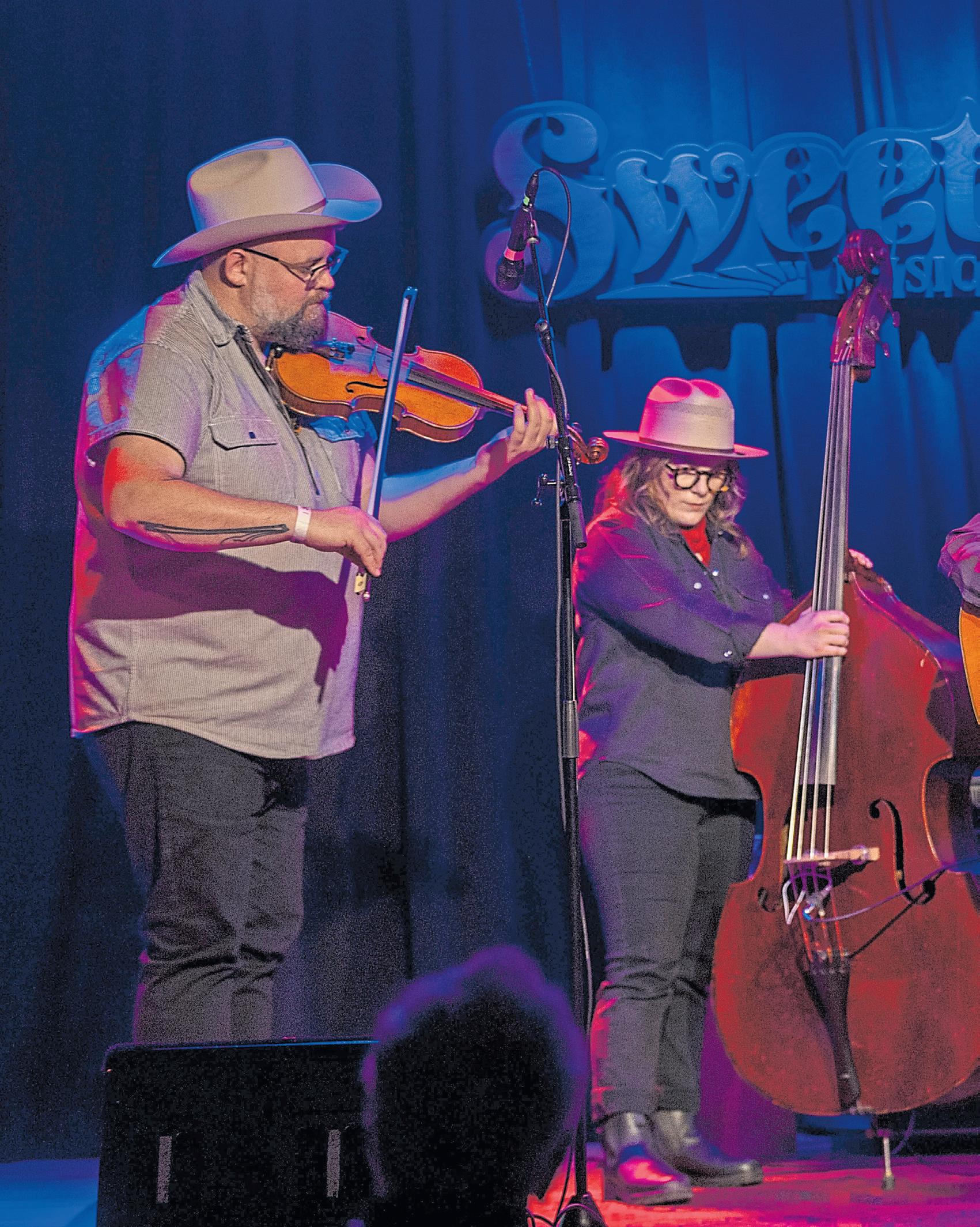
Laurie Lewis, third from left, performs with her band, The Right Hands, at Mill Valley’s Sweetwater Music Hall in March.
as a teenager was an awakening for Lewis, whose father was a classical flutist.
“We just had classical music going all the time,” Lewis recalled. “But that really opened my ears to traditional music, folk music, of all stripes.”
Her father arranged for her to take banjo lessons from a student at UC Berkeley, who let her explore his bluegrass record collection — at a time when most teens were grooving to Jefferson Airplane, the Grateful Dead and Creedence Clearwater Revival.
Lewis drifted away from music and explored modern dance while attending classes at UC Berkeley, but the break didn’t last long. She soon

“It wasn’t until I started touring nationally that I realized what an oasis this place was and what a good place for me to get into the music, because it was completely acceptable.”
Laurie Lewis
discovered there was a vibrant bluegrass and acoustic music scene centered at a pub in San Francisco called Paul’s Saloon with music every night, including a jam night where “where people would just get together and play.”
Lewis found several things set the Bay Area music scene apart even then. “It was less people trying to outplay each other with their hot licks and more just playing together in the service of the music,” Lewis said.
And while there were women stars, bluegrass and folk were still male dominated on the national scene. Not so here: “When I started playing bluegrass at Paul’s Saloon, the first two bands I saw had women, and I just thought that’s the way it is.”
Lewis had joined The Phantoms of the Opry as a bass player, but when it disbanded, she co-founded one of the first all-women bluegrass bands — the Good Old Persons — whose other members included Kathy Kallick.
Playing music at bars, pizza parlors and other small venues was never great money, but it was enough to get by in those days. There also were midsized venues, like the old Freight & Salvage, where more serious local groups could build their audience as opening acts. The Freight moved to a larger, $12 million venue in 2009 with expanded capacity to accommodate the growing interest in acoustic music, but Lewis said in the process, the region lost a venue suitable for developing musicians, something she hopes will be remedied soon.
“You’re either playing for 12 people in a bar or 400 people — you need something else,” Lewis said.
Lewis was fortunate to buy a house years ago with a small inheritance, which she says “has been my life raft and what’s
enabled me to stay and play music here.” Of her current band The Right Hands, only fiddler Brandon Godwin, originally from Kentucky, lives locally in San Francisco. Bassist Hasee Ciaccio is based in North Carolina, and banjoist George Guthrie in Nashville.
“Nashville has been the big place that’s been sucking all the young people away. It’s a great scene there, and people are getting together and jamming all the time,” Lewis said. “That’s what this place was like in the 1970s.”
In addition to making and performing music — she has a new album out and joined with former bandmate Kathy Kallick for a Berkeley Bluegrass Festival performance — Lewis also helps support other musicians. She teaches music camps at the California Bluegrass Association’s annual Father’s Day Bluegrass Festival in Grass Valley and offers musical river-rafting trips. Her RiverWonderGrass trip this June on the Yampa River already is sold out, and she’s doing Bluegrass on Whitewater on the Rogue River in September.
In spite of the challenges facing budding bluegrassers in pricey Northern California, Lewis is inspired by the young talent that somehow finds a way.
Tuttle, with whom she’s collaborated musically, has called Lewis “one of my earliest heroes and influences.” And emerging bluegrass star Daisy Caire of Placerville has said Lewis “made my musical dreams come true.”
“I think it’s having a little revival right now. I just hope that it catches on and can make enough money for enough people that they can figure out how to stay here,” Lewis said. “You need young people. . . I love the music, and I’m happy to be a part of it. And to be seen as still relevant in that scene is a blessing.”
When Corinthia Peoples seated herself in the front row for Bobby McFerrin’s weekly Circlesongs performance at Berkeley’s Freight & Salvage, she didn’t look like someone who lacked confidence.
The San Francisco resident came to the communal sing-along elegantly dressed in flowing white and wearing silver and stone jewelry of her own design. She also wore a radiant smile — even after a prompt by McFerrin encouraged her to reveal to the rest of the audience that she harbored a deep fear about singing in front of people, due to an offhand comment made by a relative when she was a young girl. After sharing her story, Peoples got the chance to work through her fear with help from the 10-time Grammy award-winning virtuoso himself.
“We can sing together,” the 74-year-old McFerrin told Peoples, gently coaxing her into performing a gorgeous, improvised duet with him, based on the “Sister” lyrics in the “Miss Celie’s Blues” song from the 1985 film, “The Color Purple.”
Such moments of healing, community and celebrating life through music are commonplace at McFerrin’s Circlesongs. Every Monday at noon at the downtown Berkeley venue, the jazz artist and his a cappella group Motion — made up of Destani Wolf, Tammi Brown, Bryan Dyer and Dave Worm — present vocal jam sessions. They use their voices like instruments to riff off well-known lyrics and create spontaneous, scatlike harmonies and vocal percussions. Most importantly,
Musicians Bryan Dyer, from left, David Worm, Bobby McFerrin, Destani Wolf and Tammy Brown perform on stage during McFerrin’s weekly Circlesong gathering at Berkeley’s Freight & Salvage.
JOSE CARLOS FAJARDO/STAFF

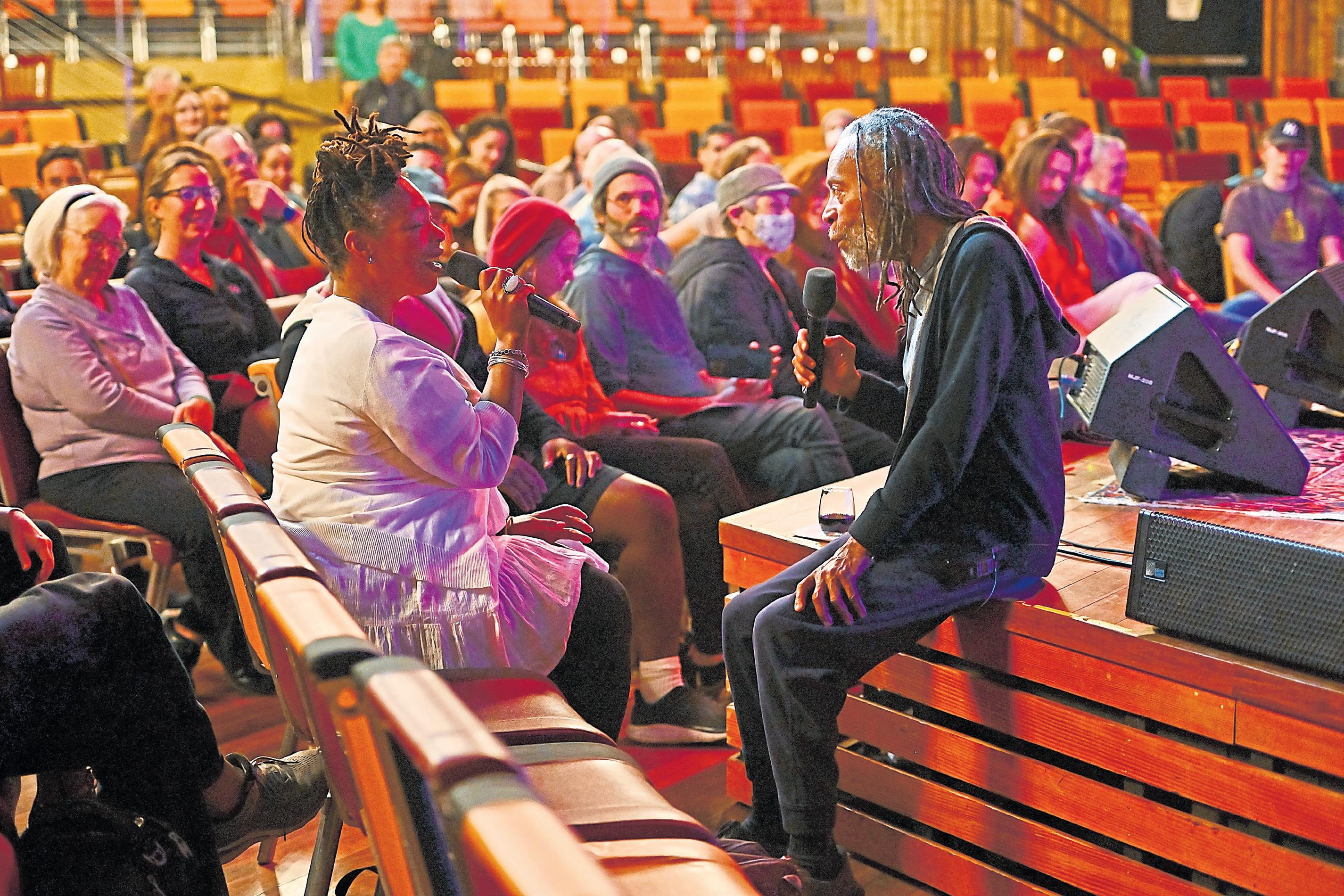
they invite everyone in the audience to join in, regardless of musical experience.
“Every voice has a place in the circle,” McFerrin has said.
Peoples attended her first Circlesongs on Feb. 26. During a pause in the music that day, McFerrin, who became globally famous for his four-octave range and 1988 hit, “Don’t Worry, Be Happy,” told the 200 people in the audience, “I wanna know what you’re feeling. Tell me what’s on your mind!”
That’s when Peoples spoke up, explaining that she once dreamed of being an entertainer before being told she’d never be
good enough.
“What is music?” she asked.
As the slender McFerrin stepped off stage to engage directly with Peoples, he almost seemed to be playing the role of wise man, offering healing words. Indeed, some audience members referred to him as a shaman or said that attending Circlesongs is like going to church. With Peoples, McFerrin offered what sounded like a sermon on the nature of music, explaining how it has many dimensions and modes of expression, with an unlimited reach into the soul and imagination.
“Music is playful! Music is
With Bobby McFerrin’s encouragement, Circlesongs attendee Corinthia Peoples sang a song from “The Color Purple” during a session at Berkeley’s Freight & Salvage on Feb. 26.
JOSE CARLOS FAJARDO/STAFFdangerous! Music is spiritual,” McFerrin said, with some of that playfulness. When Peoples and others in the crowd also suggested music is “power,” “community” and “vibration,” McFerrin nodded and added, “It’s B-flat! It’s a language that everyone can understand.”
After McFerrin encouraged Peoples to start their duet, the first words that popped into her head were from “The Color Purple.”
“Sister,” she began. “You’ve been on my mind.”
McFerrin repeated “sister” and began to hum. As their voices rose together, they seemed
to lose themselves. The Motion crew worked their way in, with Wolf and Brown offering soaring vocals and Dyer and Worm delivering a bass line and vocal percussion, and audience members joined in, too.
Their duet over, McFerrin said to Peoples, “I don’t know if you know this, but we sang about five different keys. Everything you sang was surprising. I love surprises.”
“It is our birthright to sing just for ourselves,” Wolf said. “Each of us has our own unique voice, and we get to use it however we want to use it.”
McFerrin, who has been open

about living with Parkinson’s disease, has hosted Circlesongs around the world since he released his 1997 album of the same name. In 2021, he and Motion brought the practice to Freight & Salvage, with the quintet celebrating their 100th performance there in early March.
Almost as soon as McFerrin picked up the microphone on this particular afternoon, audience members began to sing along, tap their feet or shimmy in their seats. A few people danced in the aisles, and McFerrin and the Motion performers invited 2-year-old Runa Nayak
of Oakland to wander on stage, before the little girl returned to the arms of her mother, Io Nayak.
Regular attendee Daniel Bowman Simon said it’s common for McFerrin and his crew to incorporate children’s cries or other noises into the music. This performance, like many others, had a school group in attendance, in this case, Marin Academy ninth graders.
“It’s one of the most delightful, joyous, completely surprising ways to spend 90 minutes,” said Simon, a Berkeley resident.
“People might not know the name Bobby McFerrin or know
Bobby McFerrin accepts the Recording Academy Lifetime Achievement Award with his children Madison, Jevon, and Taylor at his side at the Recording Academy’s Special Merit Awards on Feb. 4, 2023, at the Wilshire Ebell Theatre in Los Angeles.
CHRIS PIZZELLO/ ASSOCIATED PRESSwhat Circlesinging is, but they definitely know the song ‘Don’t Worry Be Happy.”
When Simon invites people to join him and sing “with Bobby McFerrin,” they often say, “I can’t sing!” Simon tells them, “You don’t have to sing, but I can’t guarantee you that you won’t.”
It’s hard not to burst into song, what with the feeling of miracles large and small unfolding across the room. When a Circlesongs regular presented Brown with a portrait she created in her honor, the Santa Cruz-based vocalist revealed that she was in remission from
Stage 4 cancer. It had metastasized to her lungs, leaving her struggling to breathe and to sing. But, Brown said, “Talk about the power of singing and healing: Circlesongs was very much a part of my healing. Bobby called me every day. (And) with your prayers and support and thoughts and God’s mercy, I’m here.”
And Peoples felt she had experienced her own Circlesongs miracle when she finally sang in front of people again. “It was like something inside me had been bottled up, but the top was lifted,” she said, “and the genie came out of the bottle.”
Music has shaped us, our consciousness and how we build our societiesSTORY BY KATIE LAUER
ILLUSTRATION
BY DAVIDE BARCOhen was the last time music made the hairs on the back of your neck stand up, sent a chill down your spine or gave you goosebumps all over?
Whether it’s a full-body rush from joining in an outdoor choir of 58,000 Swifties at Levi’s Stadium or a shudder from the evocative tension that’s made Samuel Barber’s “Adagio for Strings” cinema’s unofficial mourning song, those moments spark a psychophysiological phenomenon or frisson.
The first time that intoxicating sensation rattled Jeremy Wagner — a composer, lecturer and the technical director of the Center for New Music


Neuroscientist Daniel Levitin’s 2007 book, “This is Your Brain on Music,” explores the intersection of art and science.

In his 2008 follow up, “The World in Six Songs,” Levitin argues that fundamental song types — songs about love, for example, or religion — enable social bonding.
Center for New Music and Audio Technologies technical director Jeremy Wagner is a composer, lecturer and the technical director of the Center for New Music and Audio Technologies at UC Berkeley.
ARIC CRABB/STAFF& Audio Technologies at UC Berkeley — was during high school, when he was flooded with emotion while listening to the orchestral swells in the Beatles’ 1967 track, “A Day in the Life.”
This physical reaction is commonly associated with a fear response in the animal kingdom — puffing up fur, for example, to fend off predators or keep warm. But Wagner said dynamic musical changes in melody, pitch, tone and rhythm can trigger a more evolved or even subtler form of that same mechanism in humans, replicating that same bodily tingling during moments of awe, sadness, thrill or novelty.
“For me, the feeling of frisson is most profound when you have that sense of awe, when you’re in the presence of something that is spectacular or difficult to access. Some people might call it the ‘divine’ or something bigger than yourself,” Wagner, 43, said. “The artistry at work is what’s causing the experience of awe, leading to that physiological response.”
Wagner leads a course at UC Berkeley that analyzes the exact oddities that lie at the nexus of music and perception. Researchers have uncovered many reasons why and how music is so integral to life as we know it. Musical styles and artists that are enjoyed as a child, for example, often influence lifelong music tastes, largely because those songs were introduced at a time when brains are the most “plastic” and able to make connections.
However, there’s still a lot of unknowns shrouding what feels like such a deeply innate part of being human.
Wagner said that while brain imaging can illustrate which parts of the brain are active, for

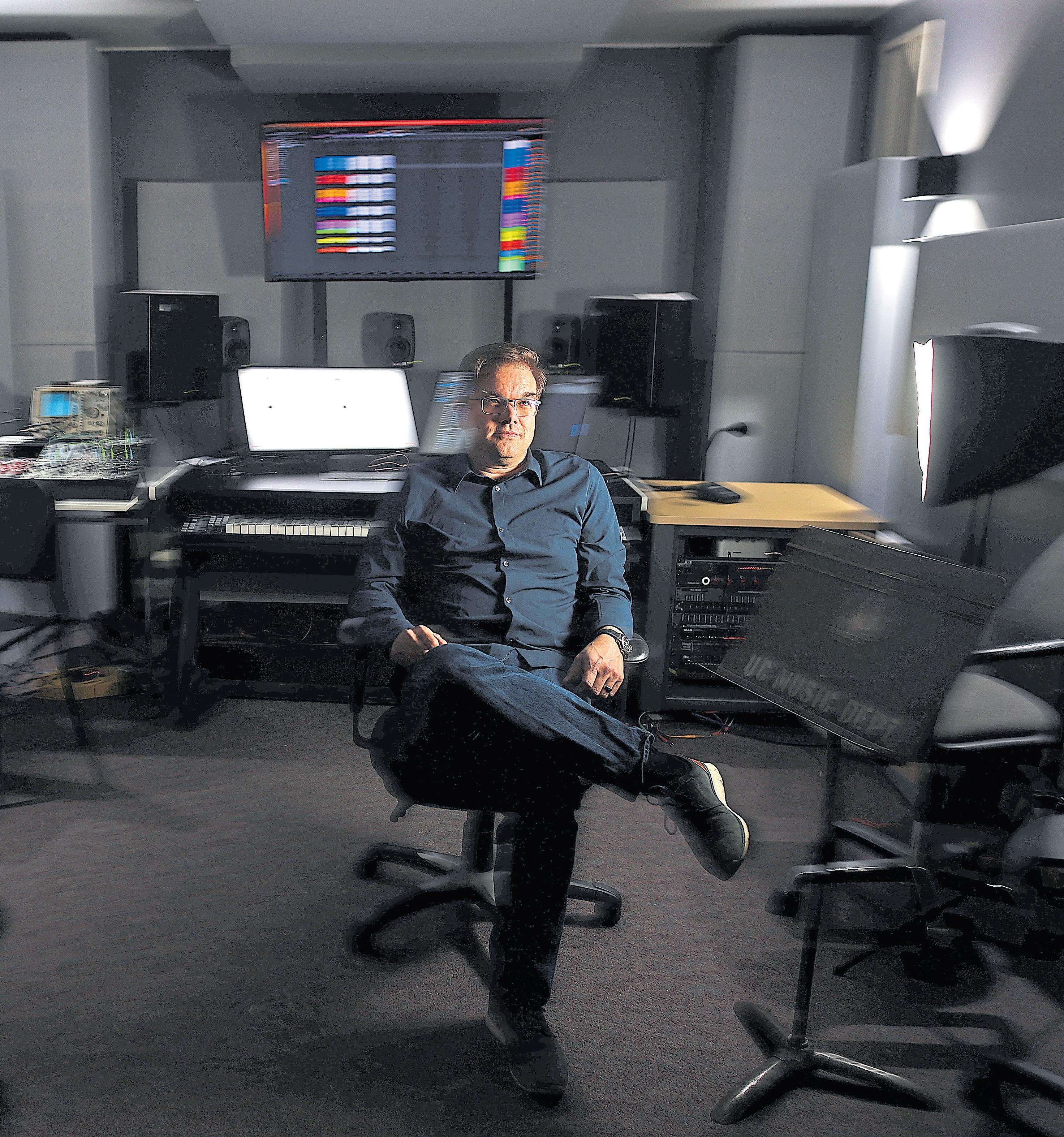

Daniel Levitin,a rocker-turnedneuroscientist who grew up in Moraga,does research that uncovers the evolutionary forces behind our brains’ ability to translate music into meaning.
ROSE EICHENBAUMexample, when people listen to music and feel frisson, medical scans fail to fully explain why the experience is enjoyable. Yet, he said, those unknowables can still act as stepping stones that guide intuitional understanding of why we enjoy music.
“When you’re looking at this data in the brain, a single cubic millimeter has hundreds of thousands of neurons participating, so the fact that something is lighting up might give us a hint at what’s going on, but it’s not really telling us the whole story,” he said. “There’s this horizon beyond which it’s kind of difficult to know anything for certain, so I try to emphasize intuition.”
One thing is certain: Music has been a facet of civilization for tens of thousands of years. Researchers have discovered ancient artifacts, such as bones that were hollowed out and carved with holes — not dissimilar to a modern-day flute.
Daniel Levitin, a rocker-turned-neuroscientist who grew up in Moraga, has delved deep into the evolutionary forces behind our brains’ ability to translate music into meaning, a development that has shaped the history of humanity in the process.
Two of his New York Times best-selling books — “This Is Your Brain On Music” and “The World in Six Songs” — collectively explain how the mind is a natural change detector. It crafts understanding of the world by searching for patterns and connecting feelings to memories.
Starting by age 5, he says, children can typically identify when a note is off key or a chord is out of sequence. Over time, those skills form a sort of mental rule book about music, specific to the culture in which you’re born.
Simultaneously, people’s
One thing is certain: Music has been a facet of civilization for tens of thousands of years. Researchers have discovered ancient artifacts, such as bones that were hollowed out and carved with holes — not dissimilar to a modern-day flute.
reward centers trigger positive emotions when listening to music they like. As this happens in groups of people over time, Levitin says, song and dance physically help synchronize minds and form larger communities — effectively laying the foundations for civic life and society as we know it today.
“Music may have evolved not for one reason, but for several distinct reasons: keeping you in your loved ones’ thoughts when you’re not around; for comfort, friendship, ritual and religion; to express joy and to convey knowledge,” Levitin said at a TEDxUSC conference in 2012.
“For reasons we’re just beginning to understand as neuroscientists, music brings us outside ourselves and puts us in touch
with thoughts of a higher power or higher order, inspiring us to achieve loftier goals than those in our own self interest.”
Wagner said it’s vital to view music through this human-centric lens that has facilitated communication for centuries, especially now as anxieties swirl about the ways artificial intelligence and algorithms could potentially impact or even redefine the music industry in the future.
Even as he leads research in new ways to integrate technology into composition, Wagner is not worried about undue influence from Silicon Valley, which has already produced text-to-music generators that spit out something that looks and sounds like music.
Rather, it’s the intrinsic
human element of communication, connection and cognition that makes music so impactful to the heart, mind and soul — regardless if it’s brought to life by bone-carved flutes, bedazzled wireless microphones or Sgt. Pepper’s Lonely Hearts Club Band.
“Crucially, (A.I) is missing the human element — this communication between people who are trying to inhabit the same space, the same idea, the same world — that actually makes music meaningful,” Wagner said. “I spend every day working on technology to try to make music, but if there’s not a human at the center of it, I feel like it’s kind of a failure, because it’s so hard for something like that to connect with anyone.”
Singer Johnny Mathis, center, performs at a studio session in 1957 with Cuban percussionist Cándido Camero.
Drummer Art Blakey and singer Tony Bennett were also at the session.
HULTON ARCHIVE/ GETTY IMAGESThese unique Bay Area singers were standouts in their genres
BY ANDREW GILBERT
Members of the rock ’n’ roll group Creedence Clearwater Revival — Stu Cook, Doug Clifford and John Fogerty — appeared at a press reception on September 10, 1971, in London as part of their European tour.

it comes to nurturing extraordinary, unmistakable voices, the Bay Area’s track record is enduring and unimpeachable.
There’s no single explanation for the glorious profusion of singers who’ve grown up here or gravitated to the region, though it’s been a magnet for ambitious dreamers, seekers, misfits and the creatively inclined since the discovery of gold. The powerful lure of opportunity and discerning audiences have maintained a steady pull for at least a century, but so has the promise of artistic freedom, particularly compared to the grind of the star-making machinery that governs Los Angeles.
As a cradle for nurturing talent, a proving ground for rising stars and a destination for established masters, the Bay Area also provides abundant natural beauty for inspiration. Tony Bennett’s heart-on-his-sleeve crooning about the charms of San Francisco made him one of the city’s most beloved adopted sons, but it’s fellow 1950s romantic, Johnny Mathis, who embodies the Bay Area’s embrace of vocalists who break the mold.
Though he was born in Texas, Mathis grew up in San Francisco’s Richmond District, where his father, a former vaudevillian, recognized his talent early on, encouraging him to study

piano and perform hits of the day. Coming of age in the late 1940s, Mathis fell under the sway of the era’s consummate pop vocalists, particularly Lena Horne, Nat “King” Cole and Bing Crosby, all artists who used their foundation in jazz to interpret a rainbow spectrum of styles.
Mathis hasn’t been much of a presence in 21st century popular culture, so it can be easy to forget what a Billboard titan he was in the 20th, ranking as the century’s third best-selling artist, with an astounding 360 million records purchased worldwide. And he’s still making audiences swoon at the age of 88, with concert dates around the country booked through the fall (next up in California: June 22 at the Pechanga Resort Casino in Temecula).
Although often pegged as a romantic crooner, Mathis has never limited himself to the lushly orchestrated ballads that made him a star, like “Chances Are” and “Wild Is the Wind.”
Mary Stallings and Duke Ellington take the stage at the Monterey Jazz Festival in 1965.
STAFF ARCHIVES
He was game for just about anything, recording bossa novas and boleros, soul, R&B, blues and country tunes, sounding comfortably himself in each idiom.
Stylistic diversity was also a hallmark of the Pointer Sisters, the iconic Bay Area vocalists who emerged from Oakland’s thrumming late 1960s music scene. The version of the group that first hit the charts included all four Pointers: June, Bonnie, Anita and Ruth. Forged in the Black church scene, their gospel-infused vocals drew on their Oakland roots while absorbing grooves and instrumentation from experimental-minded artists like Stevie Wonder, Kraftwerk and Herbie Hancock (whose seminal 1973 album “Head Hunters” was inspired by East Bay funk).
The tight sister harmonies put a Pointer stamp on just about any kind of arrangement, and they explored everything from R&B, pop, and bebop to electronic music, funk, disco,
soul and rock. At a moment when Beyoncé has shaken up Nashville with her single “Texas Hold ’Em,” remember that the Pointer Sisters won a best country vocal performance Grammy award in 1975 for the song “Fairytale.”
The sisters were just getting started, though Bonnie decided to try her luck as a solo act in 1977. Working as a trio, the Pointers went on to win two more Grammys while scoring a series of top 10 hits, including “Automatic,” “Jump (For My Love),” “Fire,” “He’s So Shy” and “Slow Hand.” At a time when radio formats, nightclubs and the emergent MTV siloed Black acts into specific genres or ignored them altogether, the Pointer Sisters refused to limit themselves, claiming their full creative potential with each new stylistic venture. Audiences can be fickle, but the Pointer’s hometown following stuck close, continuing to embrace the localgirls-made-good through every innovation.
The Bay Area can’t take credit for the eclectic streak that has run through the remarkable career of Frederica von Stade, but the legendary mezzo-soprano has also found plenty of support here for her musical curiosity. By the time she moved to Alameda in the early 1990s for her second marriage, she was already a revered and beloved figure in the world of opera and concert music, known for ravishing renditions of Mozart and Mahler and her Francophone favorites, Berlioz, Debussy, Ravel and Canteloube. But she ranged far beyond the bel canto canon, including songs from around the world in her repertoire as well as from contemporary composers like San Francisco’s Jake Heggie, for whom she’s served as a muse.
Inducted into the Opera Hall of Fame in January, she’s an anti-diva and a perfect fit for the region. Witty, urbane and utterly unpretentious, von Stade introduces herself as Flicka while often noting the name came from her father’s favorite polo pony (though he — her father — died before she was born). Largely retired from concertizing since 2011, von Stade is committed to music education, organizing and underwriting choral groups in East Bay schools that lack robust music programs. At the height of the pandemic in 2020, inspired by her experience working with the Dallas Street Choir, she launched the People’s Choir of Oakland for unhoused or formerly unhoused singers.
If von Stade’s spirit and voice soars to the heavens, the Bay Area has also produced singers weaned on gravel, mud and fire water. Though the only Delta that El Cerrito’s John Fogerty got close to while growing up was near Sacramento, his gritty vocals seem to be hewn from the
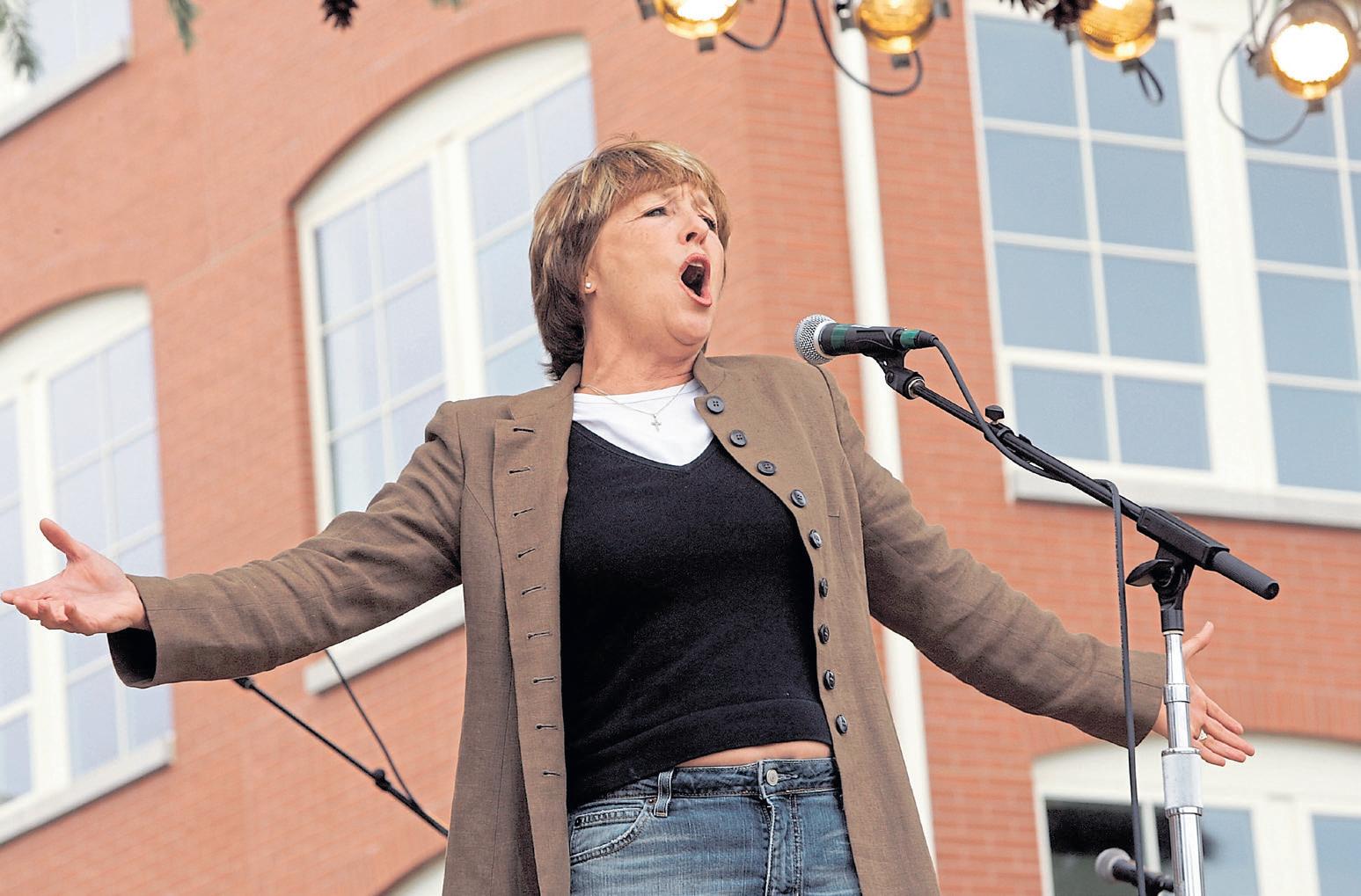
banks of the Mississippi River. He wasn’t born or raised on the bayou, but his swampy soul came out in every syllable and stinging lick as the lead vocalist, lead guitarist and primary songwriter for Creedence Clearwater Revival.
Rather than pursuing a variety of styles and approaches, he built on the ferocious energy of rockabilly and the compressed, portentous narratives of Delta blues to create his own indelible sound. During an extraordinary run from 1969 to ’71, Fogerty recorded a revelatory body of songs that stood in stark contrast to the Bay Area’s prevailing ethos exemplified by the Grateful Dead’s extended jams.
While many other acts recorded Creedence songs, Fogerty’s high, clear, muscular tenor, full of righteous rage, dark prophecy and barely contained panic, defined 14 consecutive Top 10 singles and five consecutive Top 10 albums. He’s still on the road at 78, belting out timeless Creedence hits like “Bad Moon Rising,” “Fortunate Son” and “Run
Above: Frederica Von Stade was among the soloists during filmmaker George Lucas open house for his then-new Letterman Digital Arts Center on June 25, 2005, in San Francisco.
Through the Jungle,” sounding mostly untouched by time. When it comes to defying the calendar, no Bay Area vocalist seems to have struck a better Luciferian bargain than jazz great Mary Stallings. A San Francisco native who came of age during the nightclub glory years of the late 1950s, she was still a teenager when she started performing with established stars such as Louis Jordan, Ben Webster and Teddy Edwards.
Though she made her first jazz album in 1961 at the age of 22 (the impressively poised “Cal Tjader Plays/Mary Stallings Sings”), her recording career didn’t take off until well into middle age.
At 84, she’s among the best jazz vocalists in the world, performing monthly at Keys Jazz Bistro in North Beach, singing in a venue formerly occupied by the storied El Matador, where Stallings performed six decades ago. The experience has to be uncanny, but Stallings is entirely in the moment, working out arrangements with her musicians
on the bandstand, interpreting lyrics with sly understatement. The only precedent for a worldclass jazz vocalist sounding this good as an octogenarian is the late Ernestine Anderson.
Part of what makes Stallings’ voice so rich is that she carries traces gleaned from some of jazz’s most consequential artists. She didn’t record again for decades after her project with vibraphonist Tjader, but Stallings stayed busy through the 1960s, performing with jazz giants such as piano maestro Earl “Fatha” Hines, alto sax star Cannonball Adderley and the Montgomery Brothers, featuring the Indianapolis siblings Wes on guitar, Buddy on piano and vibes and Monk on electric bass.
Stallings caught the attention of Dizzy Gillespie during a gig at San Francisco’s Black Hawk, launching a musical relationship that led to several West Coast tours and a heralded performance with the trumpeter at the 1965 Monterey Jazz Festival. As jazz work dwindled toward the end of the decade, she performed for a year in Nevada with Billy Eckstine. And from 1969 to 1972 she toured internationally with the Count Basie Orchestra, though she never got into the studio with the band (although she does appear on several tracks on “Good Time Blues,” a live album recorded in Budapest in 1970 and released on Pablo in 2004).
From jazz spots to the opera house, from dance halls to rock clubs, the Bay Area has nurtured and welcomed unforgettable voices that continue to inspire and move listeners. Uncontained by any particular tradition, sound or style, these singers contain multitudes, embodying the diversity that makes life in the Bay resound to its own magnificent frequency.

Amoeba Music — you don’t have to be a microbiologist to instantly recognize that name.
Started in Berkeley in 1990 by music-loving record collectors Marc Weinstein, Dave Prinz and Mike Boyder, Amoeba sprouted locations in San Francisco and Hollywood and soon became the biggest independent music store in the world. Amoeba sells and trades records, sure, but it has also delivered legendary in-store concerts with Valhalla-level artists like Patti Smith and Paul McCartney.
Downloading, streaming and the pandemic took their toll in recent years, and Amoeba was forced to temporarily close its L.A. store. But it’s since reentered the good times, surging on a wave of vinyl demanded by a new generation of vintage record lovers. Step into the Berkeley location, and you’ll be overwhelmed by the delightful things on offer. There are sections for jazz, metal, New Orleans, soundtracks and spoken word (like “Allen Ginsberg
Reads Kaddish,” which the poet wrote on Dexedrine and LSD). There are $100 sealed Miles Davis LPs and $1 cassette tapes, T-shirts for The Germs and Public Enemy and clothing patches for James Brown and the Sex Pistols.
These days, Prinz lives in Point Reyes but spends time on Maui, where he paused during a recent tropical squall to chat.
After Prinz sold his Bay Area chain of Captain Video stores in the 1980s, he was looking for something else to get into. Shopping at San Francisco’s Streetlight Records, he met Weinstein, the store manager, and formed a fragrant bond. “I used to bring back pot from Hawaii, which he’d never had,” Prinz recalls. They decided to open an independent music store in a college town — Berkeley. “We became pretty good friends, and that’s how Amoeba started — me smoking Hawaiian pot with Marc Weinstein.”
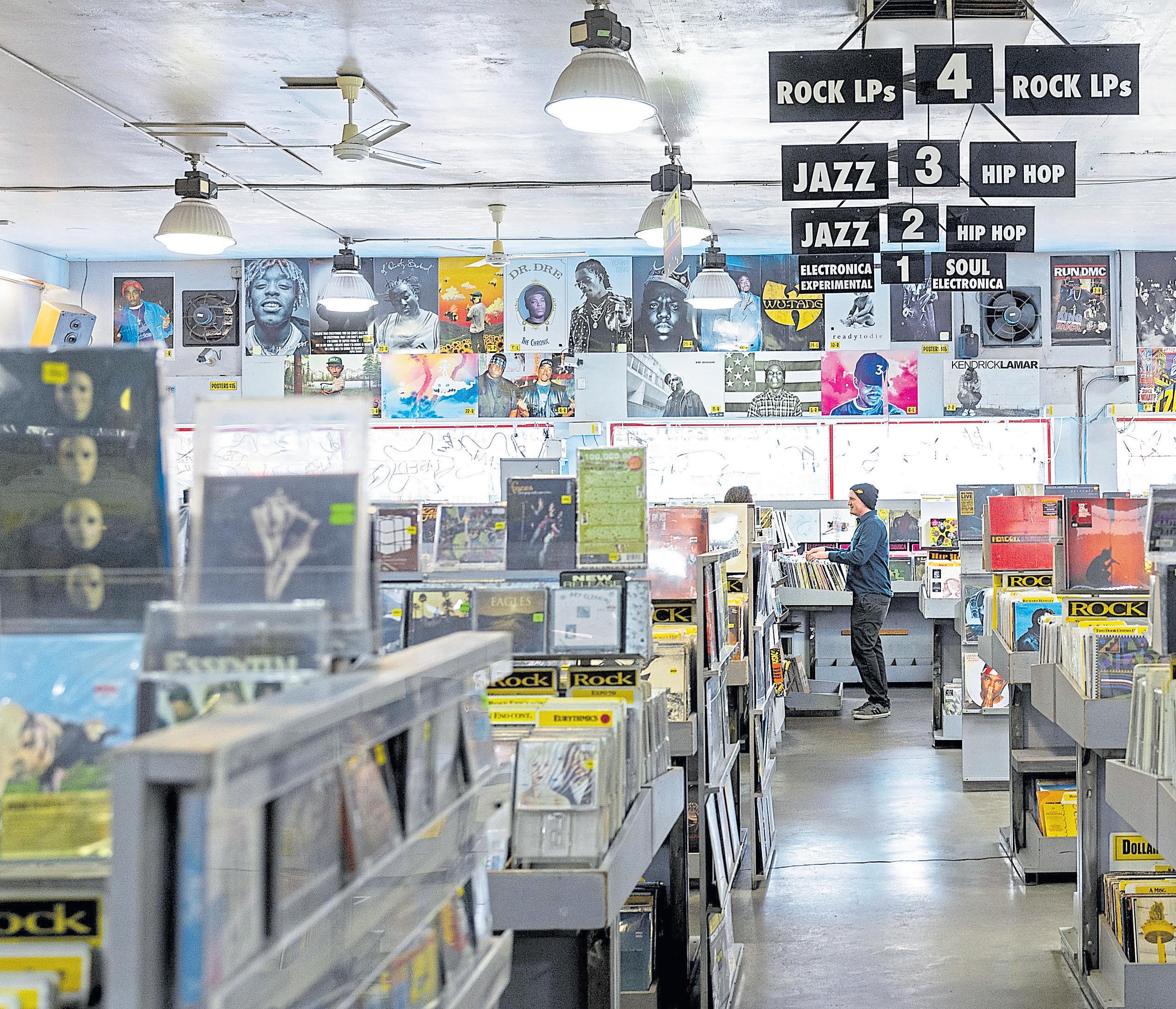

Left: Dave Prinz co-founded Amoeba Music, one of the largest independent music stores in the world, in Berkeley in 1990.
Amoeba has held in-store concerts for everyone from Nancy Sinatra to Brian Wilson, Elvis Costello, The White Stripes and Billie Eilish. Prinz’s favorite memory? In 2007, Paul McCartney and his touring band recorded a secret concert at the Hollywood Amoeba. In the audience was Alanis Morissette, Joe Walsh and Ringo Starr. “Ringo didn’t really like to be in crowds,

and he was a little nervous,” says Prinz. “I said, ‘Why don’t you stand in my row, and I’ll guard the end?’ Ringo felt comfortable enough in the crowd to watch his old bandmate.”
Eric Clapton was swarmed by customers on his visit, but Jimmy Page and Robert Plant have shopped there with no problems — though Plant, when asked to step around a security gate, joked that “for a bunch of hippies, you guys sure have a lot of rules!”
was “totally surprised” that vinyl came back
For a while, the customer base at Amoeba was aging. It
was like a baseball team with no farm system — you need young people coming up through the ranks to shop and trade, and that wasn’t happening. Then somehow, vinyl became popular again. “Kids are buying vinyl, and it’s cool,” says Prinz. “I can’t tell you why, exactly. I guess people came to the realization that it’s cool. It’s always been cool. It wasn’t viewed as cool for a while, but now it’s cool again.
“We love to have kids from UC Berkeley shop in our stores, because they’re the future of America and the future of people who are going to support the music industry. Having kids shop for vinyl again has changed everything. Go to a store on Record Store Day, and you’ll see how many there are, looking for artists they care about.”
Sales may be down for new compact discs, but Amoeba is selling more used CDs than ever before. “There’s a big market for those, because there’s a lot of stuff not on vinyl right now,” Prinz says.
Everything has its cycles. Right now, physical media is experiencing a huge boom. “Even cassettes are popular again, which is really crazy,” says Prinz. “That’s a format you’d think would be totally dead by now.”
Prinz has spent almost a decade hunting down items from the jazz giant’s 400-page discography and hopes to do, he says, what “iTunes and Spotify couldn’t do, which is actually

put a discography of an artist together correctly.” Armstrong was never beholden to one label — he recorded for more than 50. When Decca tried to lock him up by sending thugs out to “persuade” him (this was a real practice), he moved to France to record for a couple of years.
Prinz tracked down hundreds of sources from around the planet to gather and remaster his catalog. “It was like putting together a giant jigsaw puzzle,” he says. “At least half the songs in that discography weren’t official releases, and most people haven’t heard them. I’d like to get those out sometime soon as a downloading site (supported by donations). I think that’d be a real gift to the world.”
“I love collecting records, that’s how I got into this business,” Prinz says. “My dream was, I used to go into a record store, right? And I’d see this big stack of cool records that just came in and see a guy going over them and then the owner coming over to look at them. I said, ‘I want to be that guy — the guy who gets to look at the stack
Branded license plate holders are among the merchandise available at Amoeba Music.
Amoeba Music is open from 11 a.m. to 7 p.m. Wednesday-Sunday at 2455 Telegraph Ave. in Berkeley and 11 a.m. to 7 p.m. daily at 1855 Haight St. in San Francisco.
Hear Bay Beats — streaming music playlists that showcase local artists, a collaboration with the San Francisco Public Library — at baybeats.sfpl.org.
of records first, before everybody else gets in there, and you have to fight for the ones everybody wants.’ And now I am.”
Prinz has about 4,000 CDs and perhaps 6,000 LPs, but what he’s digging at the moment is playing 78s on a 1948 Wurlitzer jukebox. “I have almost every Django Reinhardt 78 — he’s one of my favorite artists — and a lot of rockabilly 78s. I just got this amazing 78 of Eddie Bond doing ‘Slip, Slip, Slippin’ In,’ which I’ve been looking for for years. I got Ray Charles’ ‘Hit the Road Jack’ recently, which is a great 78 to hear, and 10 Beatles 78s, real ones, like an acetate of the Beatles doing ‘Crying, Waiting, Hoping’ at a BBC session. That’s what I’m really into, so I’m really retro.”
Inhibitions go out the window when they’re belting out those songsBY JOHN METCALFE
When Caitlin Bethune-Daniels met Chris Daniels on the dating app Coffee Meets Bagel, one of the ice-breaker facts she provided was that she’d won $500 in a karaoke competition singing Leona Lewis’ “Bleeding Love.”
“He saw my profile and said, ‘I could marry this woman’ out loud,” recalls Bethune-Daniels, a school teacher in Union City.
What followed was a karaoke courtship in which Bethune-Daniels tested Chris to see if he was suitable enough to visit her favorite haunt, 7 Bamboo Lounge in San Jose.
“When we first started dating, we went to the Red Stag (for karaoke), because I wasn’t quite sure if it was serious,” she says. “And you don’t bring someone to your karaoke bar until you know it’s for real.”
But it did get serious, and the two got married last year — another success story chalked up to karaoke. Today, you’ll find them singing classic R&B and power ballads at 7 Bamboo, one of the oldest karaoke lounges in the Bay Area. Their


voices join in an ocean of crooning, wailing and belting that swells nightly from dance floors in places like the old-school MelO-Dee Cocktails in El Cerrito, Effie’s in Campbell, the Mint in San Francisco and dozens of celebrated others.
Some people might wave off karaoke as a silly hobby, something to liven up boozy birthday parties and lame company events. They couldn’t be more wrong.
“Karaoke brings people together in one forum where we all can just enjoy ourselves in this moment of music and laughter and happiness,” says Keefer Harness, a financial-services agent from Sacramento who sings at Mel-O-Dee. “That’s why it’s such a great phenomenon and art form. What else is more fun than going out, having a cocktail and listening to people singing? It’s the American way.”
Karaoke around here has launched careers. William Hung began his climb to “American Idol” fame as a civil-engineering student at UC Berkeley who loved singing karaoke — disastrously, but with bulletproof confidence. In 2004, he mangled Ricky Martin’s “She Bangs” in front of a stadium of Golden State Warriors fans, wowing two of Chris Farley’s brothers in attendance. “She may bang,” they deemed, “but William rocked.”
Dedrick Weathersby is a Broadway star who has performed in “Dreamgirls” in San Francisco and recently toured the country with his own oneman show about James Brown. He’s now written another Broadway production about Little Richard, “Tutti Frutti,” premiering this winter in Dallas, and credits his success to singing at Mel-O-Dee Cocktails. Weathersby would come

in wearing a stylish wig and practice “I Feel Good” and “It’s A Man’s Man’s Man’s World” while drinking his favorite drink, water with no ice. “I was like, ‘Wow, they really like this... I actually can build a show around it!’” he says. “It was the welcoming experience of the Mel-O-Dee staff, the ownership and also the patrons that sparked the show that ended up with me being on a national tour.”
Having sung all over the country, Weathersby believes the karaoke crowd in the Bay is different. “It is more than just fun in the Bay Area. It’s people that probably did not get a shot or did get a shot but something happened in life, and it’s literally like a talent show.”
Karaoke is universal among race, gender and socioeconomic boundaries. Celebrities seem to enjoy it too: Joseph GordonLevitt and Jimmy Fallon did a “Late Night” showdown as David Bowie and Axl Rose,



where Gordon-Levitt parodied Axl weirdly singing Kelly Clarkson’s “Since U Been Gone.” Sir Paul McCartney participated in “Carpool Karaoke,” making James Corden shed tears with his rendition of “Let It Be.” Jewel visited a local bar for an “Undercover Karaoke” sketch with Funny or Die while wearing a giant prosthetic nose and singing her own music with passion. “You could be an ugly girl with a voice like that,” a female listener told her, “and you’d get laid all the time.”
The celebrity sightings around here are a little more mundane, but nonetheless notable.
“When I was up at the Mint one night, the (California) state treasurer Fiona Ma was there with friends and singing,” says Che Angkham, a San Jose karaoke singer. “She was just hanging out and wearing some costume. I was like, ‘Oh yeah, I guess I’m just here at the karaoke bar with state treasurer
Fiona Ma.’”
“Pepa from Salt-n-Pepa came in one time after she had a concert at the SAP Center,” says Keith Geddes, aka “KG Kage,” a karaoke jockey who’s worked for a decade behind the booth at 7 Bamboo. “She sang Bon Jovi’s ‘Wanted Dead or Alive,’ and after that, the bartender and I were, like, ‘Can you sing one of your songs?’ She sang ‘Push It,’ and that was awesome.”
7 Bamboo has attracted the likes of California Democratic Rep. Mike Honda, who reportedly brought his own CDs and performed slow ’60s and ’70s songs, and San Francisco 49ers players, decompressing after Sunday home games. Most often in these joints, though, you’ll find a diverse mix of ordinary folks: theater workers, part-time musicians, designers, maybe a retired heart surgeon or Golden Gate Fields horse trainer and public-school teachers — so many teachers.
“It’s funny, we get teachers from all around. It’s at the beginning of the sessions when school starts, when all these teachers come and get their karaoke in and do what they do,” says Pinole resident Delia Cavizo, a karaoke jockey for 15 years at Mel-O-Dee.
“I used to refer to it as ‘theraoake,’ because it was a good destresser,” says Bethune-Daniels, who last year taught a class of kids who grew up during online-pandemic education. “They really didn’t do kindergarten in a real way, and it was just a little chaotic.... Karaoke was a good way to break up the week and let off some steam and not have to think about what I was going back to in my classroom the next day.”
“I would see her get up on stage,” says husband Chris Daniels, “and all of the stress and all

of the pain she’d been carrying from that day would melt off her face, and she would shine. And in that moment, she was fully herself.”
The therapy aspect of karaoke is real. “Around 2012, I was not in a good place in life, I was dealing with personal emotional issues and work issues, loneliness and depression and those kinds of things,” says Eckoes, a pseudonymous karaoke jockey who lives in Modesto.
“I wouldn’t necessarily say it’s a double life, but for me, it lets me disassociate,” he says. “And without it, I definitely wouldn’t have as deep of a social network as I do now, because of those relationships I made during karaoke.”
At 7 Bamboo, a group of regulars formed a friend group called “The Boo Crew.” “I think you can question the healthy life balance of this, but sometimes we would have what we call ‘perfect weeks,’ which is when we went to karaoke every night,” says Angkham.
“Outside karaoke, we actu-
ally did a couple trips,” says Bethune-Daniels. “One time we went to Tahoe for New Year’s Eve, got a big Airbnb and a whole bunch of us came. Another year we did a trip to Vegas, where one girl was getting married, another was turning 30 and another 31, so we were finding any excuse to celebrate and making the trip all about that.”
So how do people pick their songs? Well, it turns out there can be complex motivations.
“It’s funny — what I’ve done before is get to the karaoke bar early, and I’ll choose Radiohead’s ‘Creep’ right away, because I know everyone else wants to sing it. And I know if I sing it, no one else can do it for a while,” says Chris Daniels.
“I was a pretty quiet kid when I was younger, and I think music and performing was one of my ways of building up confidence,” says Drew Jones, an account manager and musician who lives in Martinez and who performs at Cato’s Ale House in Oakland.
“I like to sing songs that people know — Goo Goo Dolls,

blink-182, The Killers and stuff like that, because I like to feel the energy in the room,” Jones says. “When it’s a good crowd, you receive some energy and give some energy back.... It just creates a really cool ball of momentum, a nice ball of energy you get rolling through the course of the night.”
Gary Miyamori is known in karaoke circles as “One and Done,” because he comes into bars to sing one song that knocks people off their feet and then departs. “I don’t bring a
Phil Perez, from San Jose, sings “Anything, Anything (‘I’ll Give You’)” during Blue Monday Karaoke at San Jose’s Caravan Lounge on March 18.
list of songs. I just wave to (the karaoke jockey) that I’m here, and she picks one,” says Miyamori, who works in I.T. and lives in El Cerrito.
Miyamori has been singing since the ’80s, back when San Francisco’s Pier 39 had a place called Music Tracks where you could broadcast your warblings to tourists outside and also record it on a cassette tape. “I bought a machine, took lessons for about eight months and had a vocal coach,” he says. “I’m also a fifth-degree black belt

“I used to refer to it as ‘theraoake,’ because it was a good destresser.”
Caitlin Bethune-Daniels
in karate. If I’m going to do something, I’m going to go all the way.”
A lot of the older karaoke singers around the Bay have disappeared, says Miyamori. “There is a new breed of karaoke singers that have emerged. I noticed them a little before the pandemic. I don’t know what drives them,” he says. “Vocally, in my opinion, they are not as good. You can always tell an old-school karaokist, even if you have never seen them or heard them before. Generally, they have their songs down pat, and the songs they sing are quite polished.
“Just the other day, I heard some woman singing a Patsy Cline song called ‘Sweet Dreams,’” he continues. “I said, ‘Who is that?’ I ran to the back of the bar to see who it was. It was an elderly woman who just started coming to the Mel-ODee, a little while ago. The whole bar stood up to see who was singing. It was so good, it sent shivers down everyone’s spine. That doesn’t happen too often.”
Most of the time, the choice of the song doesn’t matter — what matters is that the singer commits fully to the energy of the room.
“If there’s a pie chart of what I like about karaoke, right, there’s a wedge that’s your turn to sing, which is really fun,” says Stephanie Whigham, who hosts karaoke nights at San Jose’s Caravan Lounge. “Then there’s a wedge that’s listening to your friends sing. But the bulk of the pie is that it’s socially acceptable to sing along with nearly everything in this community energy of shared music.”
That’s true even if you can’t hold a tune to save your life.
“Even if you can’t sing at all,” says Whigham, “and you put on ‘Tequila’ at the right time of night and sing those three words, people love it — it’s great.”
From play-to-the crowd spots to private karaoke lounges, there’s no shortage of song centers in the Bay Area. Here are eight to explore.
Genting Karaoke: One of San Jose’s most popular karaoke destinations, Genting offers professional JBL sound systems, vertical rock microphones, a dance floor, themed rooms and a regularly updated, multilingual song selection. Take the spotlight on the small stage or book a private room ($50 to $168 per hour). 950 Story Road, San Jose; gentingkaraoke.com/
Music Land: With rooftop seating, bar games and tunes that range from K-pop to oldies, Music Land brings the heat to Milpitas. The food and drink offerings are just as diverse, serving up bar basics like french fries and mozzarella sticks, but also takoyaki, salt edamame and boba. Private karaoke rooms are $38 to $98 per hour. 788 Barber Lane, Milpitas; musiclandktv.com/home
Sodini’s: Established in 1935, Sodini’s is your classic dive bar, an everyman lounge with TVs, pool tables, darts and drinks. It’s not the swankiest spot in town, but with music-themed cocktails and karaoke nights Thursday through Saturday, there’s plenty to love. 727 El Camino Real, Redwood City
7 Bamboo: Smack in the heart of San Jose’s historic Japantown, 7 Bamboo has been bringing beats — and 145,000 songs — to the Bay since the ’70s. There’s just one stage, but you can warm up your pipes with their early evening happy hour. 162 Jackson St,. San Jose; 7bamboo.com/
Golden Lounge: One of the Bay’s fancier karaoke bars, Fremont’s Golden Lounge offers 19 private music rooms with continuously updated entertainment song systems. Prices range from $50 to $180 an hour, depending on the room. And unlike shadier joints that serve soggy, halfmicrowaved bao buns, this bar has a full-fledged, on-site Korean BBQ restaurant offering everything from steamed dumplings and potstickers to wok-fried meats. 6006 Stevenson Blvd., Fremont; goldenloungektv.com
Jaguar Karaoke: The private karaoke rooms at this pair of music spots are priced per minute, so if you go slightly over, you won’t be charged for the full next hour. The real beauty? They let you bring in your own food and drinks. The Oakland location at 4390 Telegraph Ave. is close to several Korean restaurants, so it’s perfect for a true K-Pop night. Find the Berkeley Jaguar at 2516 Durant Ave.
Mel-O-Dee Cocktails: Reminiscent of the old Las Vegas lounges of the ’60s, this vintage cocktail bar radiates retro right down to the velvety wallpaper and classic decor. Mel-O-Dee boasts a tasteful array of drinks and karaoke on the main stage Wednesday through Saturday nights. 240 El Cerrito Plaza, El Cerrito; melodeecocktails.com
The Legionnaire Saloon: K-pop meets country at this Oakland bar, where wooden furnishings and a wide whiskey collection recall the Old West with one twist: nightly karaoke! With more than 50,000 songs on tap and a live DJ, you can let your inner rock star shine. It’s a sing-to-the-bar set-up, but if you’re stage shy and want to practice until you’re pitch perfect, you can check their song offerings ahead of time at karafun.com/karaoke/. 2272 Telegraph Ave., Oakland; legionnairesaloon.com/karaoke
alk into a nondescript building in Alameda — which happens to have been the first telephone exchange on the island, circa 1900 — and you’ll find yourself plunged into an electronic wonderland of Inspector Gadget-type widgets and gizmos.
Vacuum tubes the size of baby dolphins rest on shelves near radios of all shapes and eras, clad in snakeskin, aglow with neon and disguised as Scotch whisky bottles. Transmitters from World War II bombers are stacked next to CIA communications gear and a replica of Amelia Earhart’s airplane radio. A telegraph machine clicks away in one corner, and elsewhere are unlikely treasures, like the largest black-and-white TV ever made and a recording of the Beatles that a peevish John Lennon tried to sabotage by repeatedly flushing a toilet.
This is the Bay Area Radio Museum and Hall of Fame, an institution devoted to everything under the sun related to wireless communication, stretching back some 120 years to the invention of radio. The museum is run by volunteers from the California Historical Radio Society, who open it to


the public on Wednesdays and Saturdays for tours and classes.
During these events, you might see visitors pointing to refrigerator-sized speakers and exclaiming, “Oh god, an old Ampex! That’s where my dad worked!” You can peek into a six-bench repair lab, where hunched-over workers with flashlights on their heads poke at the guts of old radio boxes to save them from landfills, looking like tech-obsessed creatures from the world of Harry Potter. If you have old 8-tracks or wax phonograph cylinders from grandma you found in a closet, you can bring them in — they’ll digitize them as part of their audio-transfer service.
The museum has led a rather itinerant lifestyle. Its thousands of mostly donated artifacts were located in Berkeley’s old KRE radio station before moving here in 2014. For much of its existence, the building has functioned as a social club and hangout space for die-hard radio collectors. But this summer, it plans to open as a full-fledged museum, with rotating exhibits and a burning mission to teach the public that radio is anything but dead.
“Radio was the fastest-adopted technology ever — including the internet and cellphones and television,” says Rachel Lee, executive director of the California Historical Radio Society. “That’s probably my favorite factoid, because these days people are like ‘Ehhh, radio.’ But it really was culture-changing — the ability to have this kind of news commu-


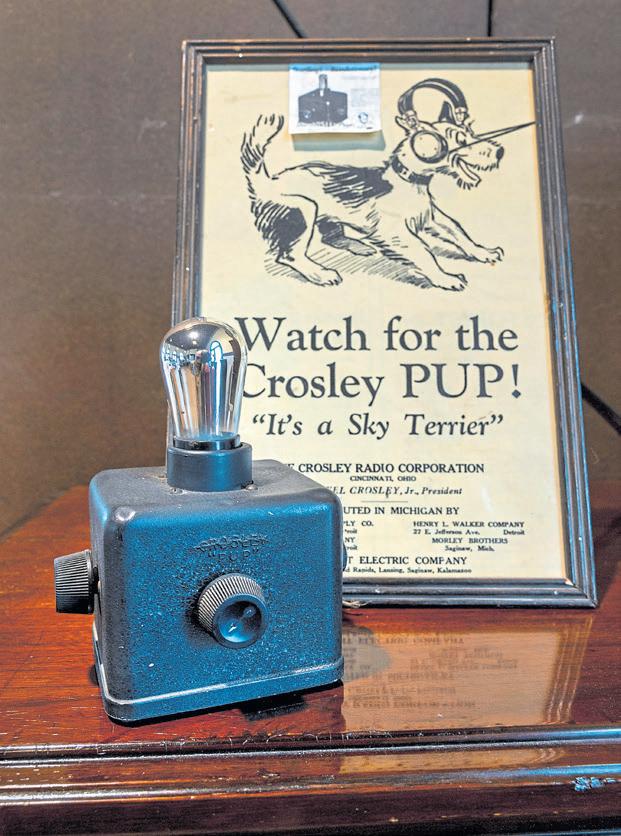


nication and entertainment was just huge in a time when you didn’t have widespread communication.”
It turns out that radio has a unique history in the Bay Area. The first entertainment broadcasts in the United States came out of San Jose in 1912, when Charles “Doc” Herrold started broadcasting musical concerts by dangling a microphone in front of a wind-up gramophone. Herrold’s cutting-edge transmitter involved a water-cooled mic and arcs burning in alcohol-filled tubes, and the broadcasts were only really available in the San Jose area. Nevertheless, the “Doc” is remembered as a radio pioneer, and his station later went on to become KCBS in San Francisco.
In the 1920s, radio experienced a growth spurt nation-
wide, expanding from a couple dozen stations to more than 450. San Francisco led the pack among all cities, with seven operating stations. The local stations included 6XG/KDN, which broadcasted player-piano music, weather reports and the price of eggs and butter from a wooden shack atop the Fairmont Hotel on Nob Hill.
The station broadcast live concerts by international opera stars and on one memorable night, an orchestra that apparently forgot to listen to the weather report. “There wasn’t enough room in the operator’s shack for the orchestra, so they stationed themselves on the roof while (radio operator Alan) Cormack positioned his microphone in the doorway,” writes radio historian John F. Schneider. “Just as the broadcast got underway, it began to rain. But the show must go on, and the little group played its entire concert in the downpour, although, as (Cormack) recalled, the violins sounded a bit ‘soggy’ towards the end.”
The nonprofit California Historical Radio Society began its journey from a collectors’ group into an authentic historical society in the early 1970s.
“There were a bunch of engineers, mostly who worked in what we called the Electronic Gulch — before it was Silicon Valley — for companies like Fairchild and Ampex. These guys collected antique radios, and in 1974, they formed a group that was basically a radio collectors organization,” says
Steve Cushman, former president and current director for the radio society. “They would meet in parking lots, and they would exchange radios and parts and schematics and books.”
If you don’t understand the appeal of this hobby, well, maybe you grew up deprived.
“I was fascinated by radio as a kid,” says Cushman. “I had a little crystal set and was always running around the house with an alligator clip, clipping onto things that would be my best antenna. In those days, in the early ’50s, the finger stop on a dial telephone — which was a little piece of metal — you could hook your antenna up to that, and you’d have the whole telephone company as your antenna.”
Most of the artifacts in the Bay Area Radio Museum and Hall of Fame are donations. On the bottom level is the largest communications library west of the Mississippi, with a whole section of novels that have something to do with radio, wartime communications or spies, including the “The Radio Boys and Girls” series of books popular in the 1940s.
The oldest piece in the collection might be a 1900 oak-clad phone booth with a telephone that can still dial out. There is British Spark equipment — one of the earlier wireless technologies, sometimes used on antisubmarine planes — and radio-station jackets from Bay Area personalities like KFOG’s Dave Morey and KOFY-TV’s Celeste Perry.

There is also one of only two remaining functional NBC chime machines. Starting about a century ago, these devices initiated and closed every NBC broadcast with a tritone “bing-bing-bong” — a sound so distinctive, it got the first audio trademark in the country. The tritone was originally played by announcers physically hitting metal chimes, which led to inaccurate timing and sour notes by those who didn’t study enough in band class. So the process was auto-
mated by the Rangertone company, which built machines for places such as NBC’s New York Radio City and the West Coast Radio City at 420 Taylor St.
“We have it opened up and working, so you can see the chimes going around and see how it worked for the hundreds of thousands of plays on the air that this machine was used,” says Cushman.
And you can actually buy radios here. Volunteers salvage old 1950s and ’60s-era radio
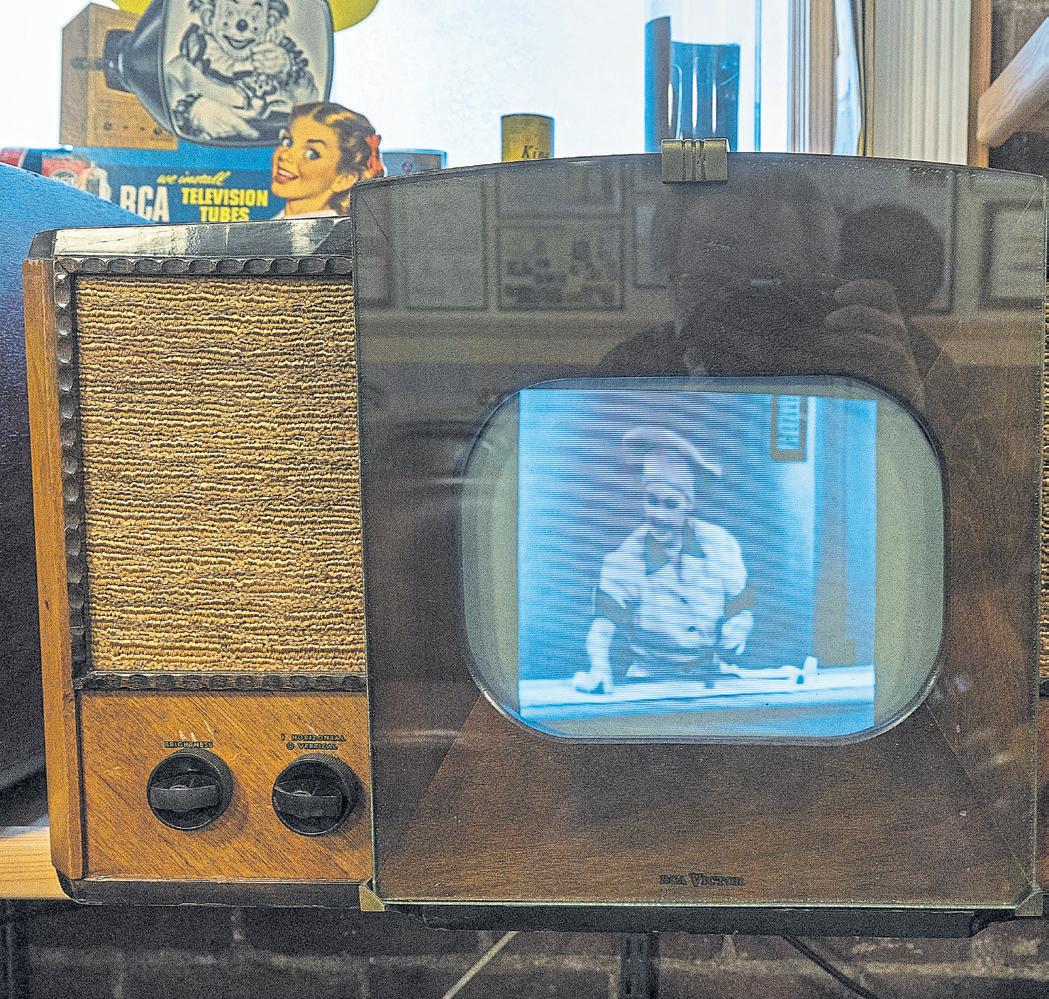



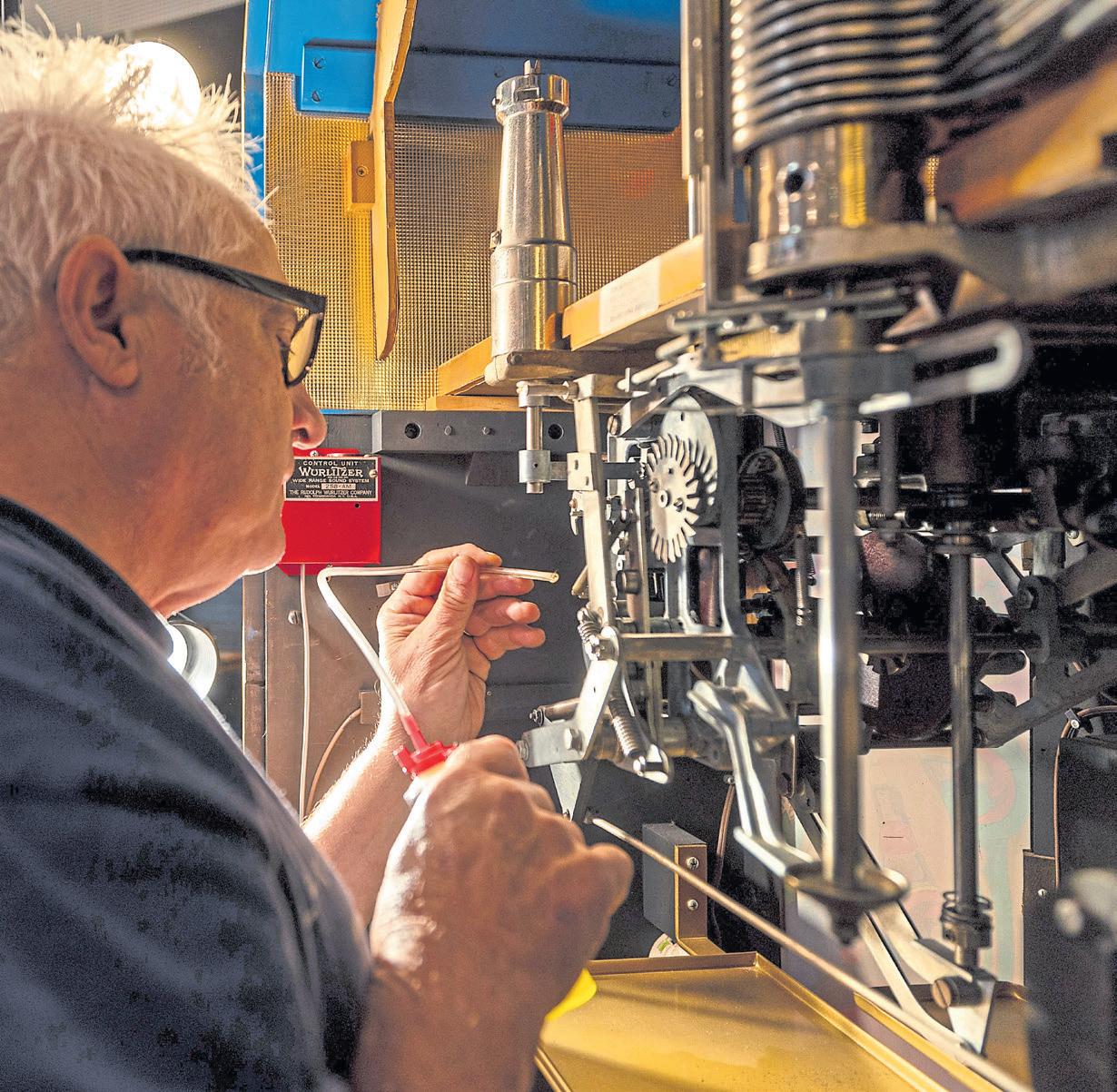
boxes, clean them up and install Bluetooth connectivity, so you can listen to music wirelessly in your kitchen.
The museum also has a ham-radio room, which is going to be hooked into the Alameda emergency network, and a soonto-deploy station at 1570 AM that will play old jazz records on old equipment. (The signal will only reach a few blocks out into Alameda but can be heard streaming worldwide on Radio Sausalito.) It has ancient TVs ranging from the 1950s IMAX of the day to a 3-inch 1940s screen, which are all wired up to play episodes of “I Love Lucy.”
The collection of recordings includes an interview with the Beatles by San Francisco talk-radio pioneer Hilly Rose, then at KCBS, who caught them in 1964 at their Hilton suite during the band’s whirlwind tour of the country.
“I showed up at the appointed time, which I remember was somewhere around 3 p.m., and all four were in their underwear lounging around,” Rose
told a radio-museum curator. “John and Ringo didn’t want to do the interview, but happily Paul and George did. John was so annoyed, he went into the bathroom and flushed the toilet continuously, attempting to foil the sound. I was using a recorder that was unidirectional and blocked out peripheral sound, so it foiled his efforts, as you can tell by the quality of the recording.”
Why is it important to preserve such history? Cushman has some thoughts.
“When a class of kids come in here, I hold up my cellphone and say, ‘All right, you guys, you know what this is?’ They say, ‘It’s your phone’ — they’ll never say telephone, because they don’t know what that is. I say, ‘No. Let me tell you the story about why this isn’t a phone, it’s a radio.’ I trace wireless communications from where we are today and work backward, so they understand what all those big brown boxes with lights are in the room.”
If three out of 20 kids take an interest in what he’s talking about, Cushman believes he’s doing a good job. “Because we’re doing what the schools aren’t doing. We’re teaching about what a great portion of society grew up with — and kids today don’t even know what a knob is.”
Details: Admission to the Bay Area Radio Museum and Hall of Fame is free. The museum is open to the public from 10 a.m. to 3 p.m. on Wednesdays and Saturdays at 2152 Central Ave. in Alameda. Learn more and explore the archives at bayarearadio.org.
If you’ve attended one of the many Italian cultural festivals in Northern California, you’ve likely heard Pasquale Esposito and been taken in by his voice and charmed by his stage presence. He’s an internationally recognized tenor and recording artist who moved from his home, Naples — also the home of his idol, Enrico Caruso — to the Bay Area more than 25 years ago.
Although he could have chosen the grand opera as a career path, he opted instead to devote his talents to pop opera and to teaching and encouraging the next generation of artists. He’s recorded more than a dozen albums, sung with the San Francisco Opera and created four PBS specials, the first a journey through Caruso’s Italy, the second a celebration of Italian piazzas, then “In the Spirit of Christmas” and “Il Tempo (Time),” dedicated to the songs that have influenced him.
We chatted with him at his family’s San Jose home, where he maintains a recording studio and classroom for his nonprofit, the Notable Music and Arts Organization.
Esposito says his grandfather heard him sing “O Sole Mio” at the age of 6 and whisked

him off to the local church, San Giovanni e Paolo, where Caruso had sung in the choir a century earlier.
“Destiny,” he says. “I am 19, 20 years and traveling. I find myself in Budapest with a friend who was playing guitar, and we are singing here and there. I met an American girl, and she invited me to visit Palo Alto that same summer. I fell in love with California.” He recalls spending $30 to use a computer at a University Avenue internet cafe to fill out
Noted Italian tenor Pasquale Esposito coaches Katelynn Lam, 12, on lip trills during a vocal exercise at his San Jose studio.
DAIa long immigration application, then heading back to Italy. A couple of years later, he received a call telling him he’d won the U.S. green card lottery. He immigrated here in 1998 and earned a bachelor’s degree in music from San Jose State University — a program he continues to support. He says: “If I didn’t meet that girl in Budapest, I wouldn’t be here.”
Esposito worked his way through college by singing in restaurants and cafes, including
Aldo’s in Los Gatos, Cafe Fino in Palo Alto and Siciliano in Redwood City.
His engaging personality prompts most people to simply call him “Pasquale.” But the correct pronunciation of his last name is Es-PO-si-to. “Many people murder my last name. I never correct them.”
“‘La Boheme’ is definitely one of my favorites. And ‘Tosca’ is what I like to listen to in order to relax. Puccini was a genius. What he did was revolutionary. He thinks like a singer and prepares you for the high notes,” which Esposito says explains the composer’s impact on many modern-day musicals.
Esposito is passionate about spreading the joy of music. His nonprofit Notable Music and Arts Organization gives scholarships to students who cannot afford lessons. He’s currently teaching 20 students in person and virtually — including youngsters in San Jose, a girl who lives in Turin, Italy, and a priest who moved from Menlo Park to New

Jersey — and 20 more are on the waiting list.
His goal is to make students feel comfortable no matter what the music genre. “It’s unbelievable what you can achieve,” Esposito says, citing the example of a student rapper who wanted to expand his repertoire. “Now he’s singing Schubert. I get goosebumps.”
He sees the commercialization of music and the trouble that schools have funding music and arts as troubling signs and
dreams of opening a music academy in the South Bay that will reach more kids. “Art can be a path to a better future,” he says.
Esposito bemoans the loss of the type of music Freddie Mercury — and his big voice — gave the world. “After Queen and Freddie Mercury, there was no one singing rock opera,” he says, and so he aims to rectify that.
Pasquale Esposito credits destiny — and a chance meeting with a Californian in Budapest — for bringing him to San Jose, where he sings, records and teaches vocal music. DAI
“When they see me, it’s very interesting what happens. They see their grandparents, their parents. You cannot believe the sacrifice it takes for an immigrant to build a good way of life.
So when I sing ‘Volare,’ you melt.
And why? Because I am bringing back the memories of (sitting) around the table with your nonna, your nonno, your papa, the smell of the Sunday when your mother was cooking.”
He’s already booked to perform at the big Italian festas in Lodi (June 9), Salinas (July 6), Monterey (Sept. 7-8) and San Jose’s Little Italy (Oct. 6). Catch him in Sonoma on June 28 in “Pasquale Sings Sinatra, Bennett and Martin” at the Sebastiani Theatre. Find more concerts and events at https:// pasqualeesposito.com.
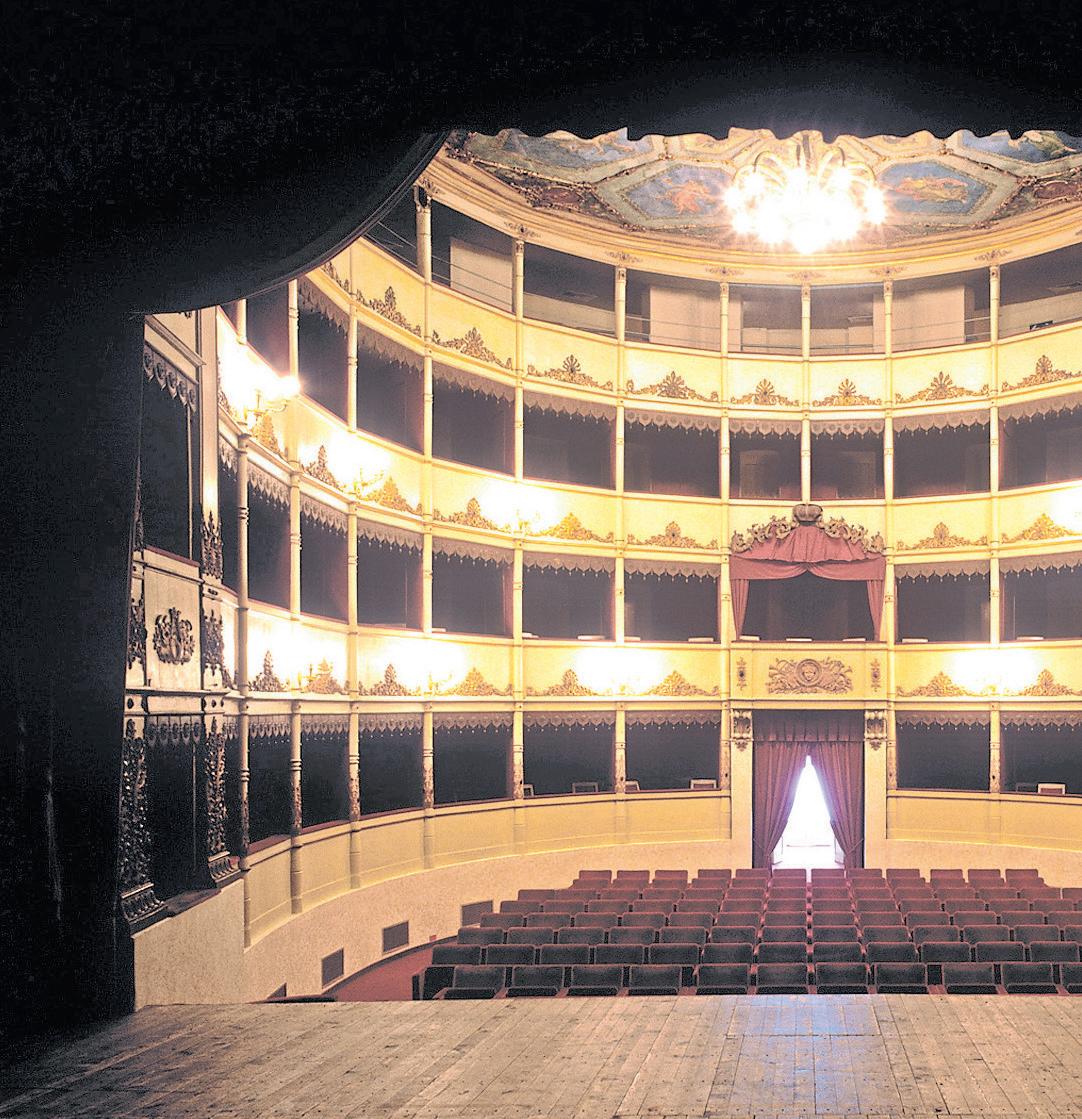

When it comes to bel canto in the Bay Area, San Francisco Opera is the giant redwood dominating the Western landscape. But this mighty institution, one of the oldest opera companies in the nation, has nurtured a lush environment underneath its canopy where numerous species thrive.
The region’s gloriously verdant opera ecosystem is nourished by an environment containing an extensive, discerning audience that supports ambitious reimaginings of classic works, traditional productions exploring the canon and new creations. And the latter is critically important if this centuries-old art form is to survive and thrive in the modern world.
Though the pandemic shuttered or severely set back several long-running arts organizations, there are more than a dozen opera companies now active around the Bay Area. These are some of the most interesting, from an East Bay company staging an opera set in Mendocino County to a modern wonder whose recent immersive works have been inspired by Mount Everest, Billie Jean King, Jay Gatsby and more.


Founded and directed by renowned Quebec-born conductor Nicole Paiement, San Francisco-based Opera Parallèle would be the apex company in most other cities. Since its 2007 launch with the world premiere of Lou Harrison’s final version of “Young Caesar,” Parallèle has cut a brilliant path with a bevy of important endeavors, including the innovative graphic opera “Gesualdo, Prince of Madness” commissioned from Dante De Silva, Luciano Chessa’s commissioned opera “A Heavenly Act” and the commissioned chamber version of John Harbison’s “The Great Gatsby.”
Paiement, who’s also director of the San Francisco Conservatory’s New Music Ensemble, is dedicated to creating opportunities for artists hailing from beyond the usual musical niches via Handson-Opera. In many cases, the program recruits composers who’d never thought about writing for opera, including jazz bassist/composer Marcus Shelby.
Working with librettist Roma Olvera, he composed “Harriet’s Spirit,” a one-act opera inspired by abolitionist Harriet Tubman that premiered at the Bayview Opera House in 2021.
Designed to bring new audiences up close to the art form “so that they’re participating rather than having them be static observers,”
Paiement said, Hands-onOpera isn’t just about creating new works. The productions often involve youth choirs and younger musicians performing alongside professionals, wearing costumes and getting swept up in “all the things that make opera magical,” she said.

Opera Parallèle’s performances this year included the SFJazz Center double header “Birds & Balls,” which combined the West Coast premiere of the comedic one-act opera “Vinkensport” by 2024 Grammy-nominated composer David T. Little and librettist Royce Vavrek, and the world premiere of the one-act opera “Balls” by 2024 Oscar-nominated composer Laura Karpman and librettist Gail Collins. It was inspired by the notorious 1973 “Battle of the Sexes” tennis match between Billie Jean King and Bobby Riggs.
On June 21-23, the company will present the West Coast premiere of “Fellow Travelers” at the Presidio Theatre, an opera based on Thomas Mallon’s McCarthy era novel adapted by composer Gregory Spears and librettist Greg Pierce.
Marking its 40th year, Opera San José was founded by the late mezzo-soprano Irene Dalis, who guided the company for three decades as general director. Now directed by Shawna Lucey and music director Joseph Marcheso, OSJ has maintained admirable financial and artistic stability with an array of opera options, including extensive digital programming via its Heiman Digital Media Studio and Initiative, community performances that often take place outdoors and youth and adult educational programs.
Part of what sets Opera San José apart is that it maintains a resident company of principal artists, which provides longterm opportunities for nurturing rising vocalists. The company also has an impressive track re-
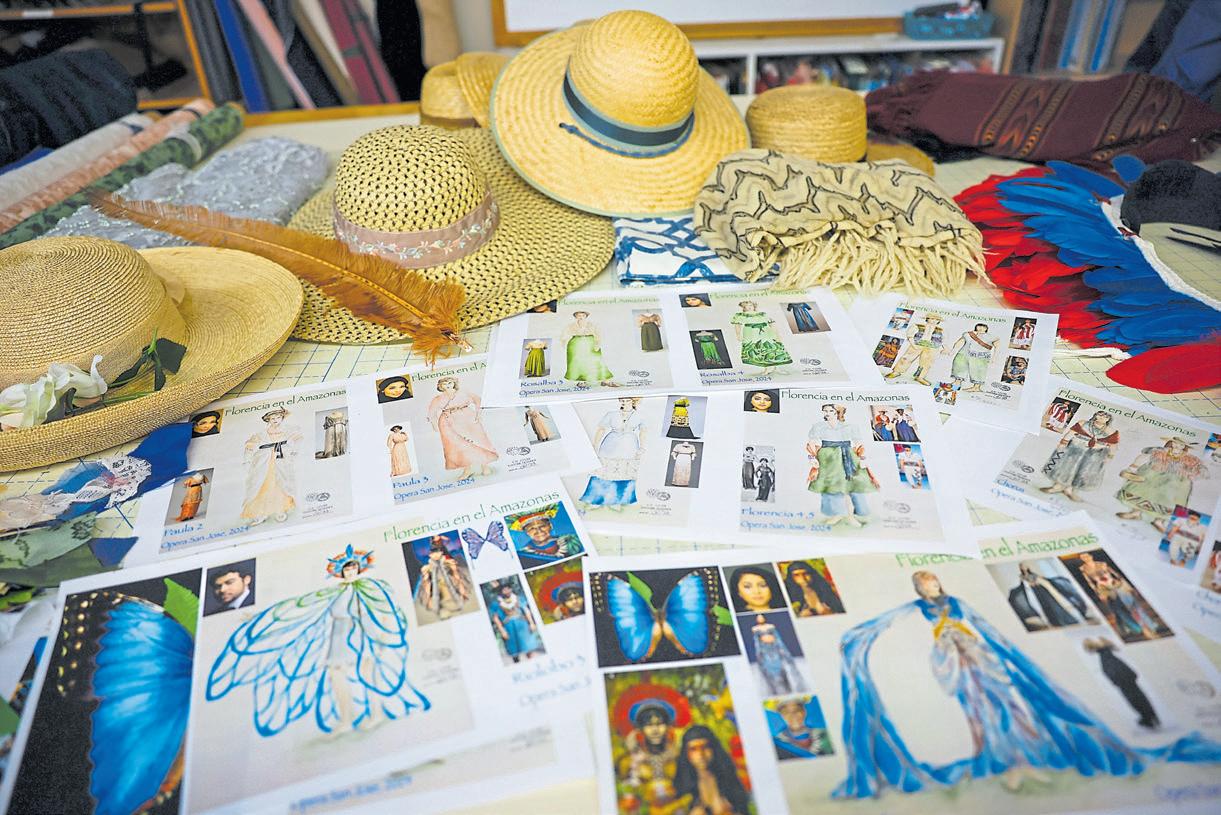
cord when it comes to bringing important work to the stage, such as the Bay Area premiere of Mexican composer Daniel Catan’s masterpiece “Florencia en el Amazonas,” which runs through May 5 at the California Theatre. Inspired by the magical realism of Nobel Prize-winning Colombian novelist Gabriel Garcia Marquez, the company’s first Spanish-language production marks the return of director Crystal Manich following her acclaimed “West Side Story.” The season continues Sept. 14-29 with composer Alma Deutscher conducting Mozart’s fanciful “The Magic Flute” Sept. 14-29, directed by Brad Dalton.
Founded in 1979 by baritone Richard Goodman as Berkeley Opera and rechristened a decade ago as West Edge Opera, this scrappy company has earned a reputation for unearth-
ing obscure works by notable composers and bringing unusual new works to the stage. Packed into two weeks from Aug. 3-18, West Edge’s summer festival at the Oakland Scottish Rite Center features three productions, starting with the world premiere of the company-commissioned “Bulrusher,” which is based on the acclaimed Eisa Davis play of the same title. Featuring Davis’ libretto and music by Nathaniel Stookey, the opera tells the story of an abandoned African-American girl coming of age in Mendocino’s remote Anderson Valley in 1955.
Distilling Wagner’s epic four-opera recounting of Norse mythology into a three-and-ahalf hour production arranged by David Seaman, the company’s popular “Legend of the Ring” returns for three nights. And the third production, “Jacqueline” by composer Luna Pearl Woolf and librettist Royce Vavrek, tells the story of virtuosic, short-lived

Members of the Opera San Jose cast of “Florencia en el Amazonas,” including Melissa Sondhi, (who plays Rosalba) and César Delgado (Arcadio), performed a community concert at the School of Arts and Culture at San Jose’s Mexican Heritage Plaza on March 22.
cellist Jacqueline du Pré via her relationship with her cello. Du Pré is sung by renowned American soprano Marnie Breckenridge, who won the Dora Mavor Moore Award for outstanding performance for originating the role, while the role of the instrument is played by cellist Matt Haimovitz.

Founded in 1977, Pocket Opera had already been an essential San Francisco institution for more than a decade before that, beloved for bringing compressed, English-language versions of classic operas to venues like the hungry i and the Old Spaghetti Factory. The brain-
child of pianist and translator Donald Pippin, who died in 2021 at the age of 95, Pocket Opera mounts fully staged productions that are marvels of concision, with top-shelf singers accompanied by the Pocket Philharmonic’s five to 12 players.
The 2024 season takes place at Berkeley’s Hillside Club, the

Mountain View Center for the Performing Arts and San Francisco’s Legion of Honor, with Otto Nicolai’s “The Merry Wives of Windsor” (June 16-30) and Puccini’s “La Bohème” (July 14-28).
Light opera is opera, too, and no Bay Area company has a lighter touch than Lamplighters, Gilbert and Sullivan specialists whose nets snare all sorts of musical shenanigans. The first season under newly appointed artistic director M. Jane Erwin, with Brett Strader in the newly created dual role of resident music director and LMT multimedia director, concludes with Rupert Holmes’ Tony award-winning “The Mystery of Edwin Drood.” Based on Dickens’ unfinished novel, it’s a deliciously farcical whodunit presented as a showwithin-show. Playing May 4-5 at Hayward’s Douglas Morrison Theatre and May 11-19 at San
By late March, costumes for the new Opera San Jose production were well underway.
Francisco’s Presidio Theatre, “Edwin Drood” ends the company’s 66th year in style.
The pandemic has taken its toll on the opera scene, with several long-running companies, such as Saratoga’s Bay Shore Lyric Opera, yet to bounce back. Several other companies have already concluded the 2023-24 season and have yet to announce the new calendar. Keep an eye out for Palo Alto’s West Bay Opera, Concord’s Solo Opera, Walnut Creek’s Solo Opera and Festival Opera and Vallejo’s Verismo Opera.
And sometimes, the most exciting productions come together independently, like the world premiere of “Before It All Goes Dark,” a new one-act opera by composer Jake Heggie and librettist Gene Scheer. Based on a true story reported by Howard Reich in the Chicago Tribune about an ailing Vietnam War vet who inherits a priceless collection of art looted by the Nazis, the production plays May 22 at the Presidio Theatre.

The Bay Area boasts a long and storied history of outstanding vocalists, one that touches upon pretty much every musical genre under the sun. These 20 essential vocal albums showcase the breadth and wealth of the offerings, representing some seven decades of incredible music and providing many hours of listening enjoyment for all kinds of music fans.
1
“Merry Christmas,” Johnny Mathis (1958)
We’ll kick off the list with one of the most enduringly popular holiday albums of all time. It came out nearly 70 years ago, and it remains such a wonderful showcase for the San Francisco-raised vocalist who has had more than 70 hits on the Billboard charts. Listen to “Silent Night, Holy Night,” and you’ll hear what made him a legend.
2
“Surrealistic Pillow,” Jefferson Airplane (1967)
Grace Slick is the most powerful vocalist — male or female — in Bay Area rock ’n’ roll history. And she’s never been better than on the Airplane’s landmark second studio album, hitting heights that few in the genre have ever reached on “Some-
body to Love,” “White Rabbit” and other key songs that helped set the soundtrack for the Summer of Love.
3
“Any Day Now,” Joan Baez (1968)
Untold thousands of artists have covered Bob Dylan, yet nobody has done it in more consistently excellent fashion than this legendary folk singer. The longtime Peninsula resident focused strictly on the Dylan songbook for her ninth studio album, which is filled with pristine and heartfelt versions of such classics as “North Country Blues” and “You Ain’t Goin’ Nowhere.”
4
“Let Us Go into the House of the Lord,” Edwin Hawkins Singers (1968)
This is a glorious collection of

gospel music, recorded by the Oakland-born Hawkins and other talented singers at Ephesian Church of God in Christ in Berkeley. There’s so much for gospel choir fans to love here, but the album is best known for producing the gospel standard, “Oh Happy Day” — an international smash hit that went on to sell a staggering seven million copies.
5
“Dance to the Music,” Sly & the Family Stone (1968)
Other Sly albums (like “Stand!” and “There’s a Riot Goin’ On”) are often ranked higher, but it’s really this second album that delivers the best vocal work of the band’s career. All four of the main voices — belonging to
San Francisco’s Jefferson Airplane, led by lead singer Marty Balin with vocalist Grace Slick, drummer Spencer Dryden, guitarists Paul Kantner and Jorma Kaukone and bass guitarist Jack Casady, took the country by storm.
ASSOCIATED
Sly, Freddie and Rose Stone as well as legendary bassist Larry Graham — meld together wonderfully across the course of two sides of gloriously psychedelic soul-funk.
6
“Toulouse Street,” the Doobie Brothers (1972)
Everything just jells for San Jose’s greatest rock group on its second album. That’s certainly true of the vocal work, with singers Tom Johnston and Pat Simmons leading the group through such first-tier gems as “Listen to the Music,” “Rockin’ Down the Highway” and, best of all, “Jesus Is Just Alright.” The harmonies (with help from excellent bassist Tiran Porter) are so on point.
7
“Silk Degrees,” Boz Scaggs (1976)
Scagg’s best-selling — and overall best — album delivers such stunners as “Lowdown,” “What Can I Say,” “Harbor Lights,” “Georgia” and “Lido Shuffle.” Throughout the 10 tracks, which collectively run just over 40 minutes, Scaggs’ vocal work remains absolutely pristine.
8
“Worlds Away,” Pablo Cruise (1978)
Arguably the most underrated Bay Area band of all time, Pablo Cruise could craft a great radio-friendly pop hit with the best of them in the ’70s. So much of that has to do with the sturdy vocals of David Jenkins, who definitely delivers the goods on the band’s hit fourth album.
9
“Fresh Fruit for Rotting Vegetables,” Dead Kennedys (1980)
This might not be a record many think of when the topic of great vocal work comes up. Yet, what singer Jello Biafra accomplishes on the DK’s legendary debut album is nothing short of a tour de force, as he twists and turns his voice in so many expressive fashions while handling material that ranges from slyly satirical to straight-up incendiary. It’s nothing short of a punk-rock master class in singing.
10
“Earthshaker,” Y&T (1981)
Oakland native Dave Meniketti doesn’t often get his due, when it comes to the conversation about the Bay Area’s greatest rockers. Yet, it’s hard to debate his place among the region’s
all-time best rock vocalists (as well as guitarists) as you listen to Meniketti showcase his strong voice and dynamic range on “Rescue Me” and other cool cuts from Y&T’s third studio album.
11
“Break Out,” Pointer
Sisters (1984 rerelease edition)
The Oakland siblings take turns under the spotlight, with Anita and June each handling lead vocals on four songs and Ruth stepping out for three. Each one does a superb job in that role. Yet, the biggest selling point is how the sisters’ voices so joyously come together and support each other on this collection of synth-soul-pop tunes. (P.S. We prefer the 1984 rerelease edition, as opposed to the 1983 original, because it includes “I’m So Excited.”)
12
“Heart Shaped World,”
Chris Isaak (1989)
Even if this album only consisted of “Wicked Game,” it would still deserve a spot on this list. Isaak’s vocal work is flawless on that haunting number, softly surging and brooding with both longing and restraint alongside James Calvin Wilsey’s gorgeous guitar work. Other album highlights include the title track and “Don’t Make Me Dream About You.”
13
“The Revival,” Tony!
Toni! Toné! (1990)
The Oakland outfit took its game to the next level on its sophomore outing, following on the momentum built with the 1988 debut “Who?” and delivering a soulful platter that spent more than 60 weeks on the pop charts on the way to reaching


platinum-plus sales figures. The two Wiggins brothers — D’Wayne and Raphael (who later went by the last name of Saadiq) — nicely split up the lead vocals on this collection of R&B goodness.
14
“Funky Divas,” En Vogue (1992)
One of the finest R&B/pop albums in Bay Area music history, this record borrowed from all sorts of different genres — from doo-wop to hip-hop — as it showcased the mighty vocal work of Terry Ellis, Cindy Herron, Maxine Jones and Dawn Robinson. The highlights are
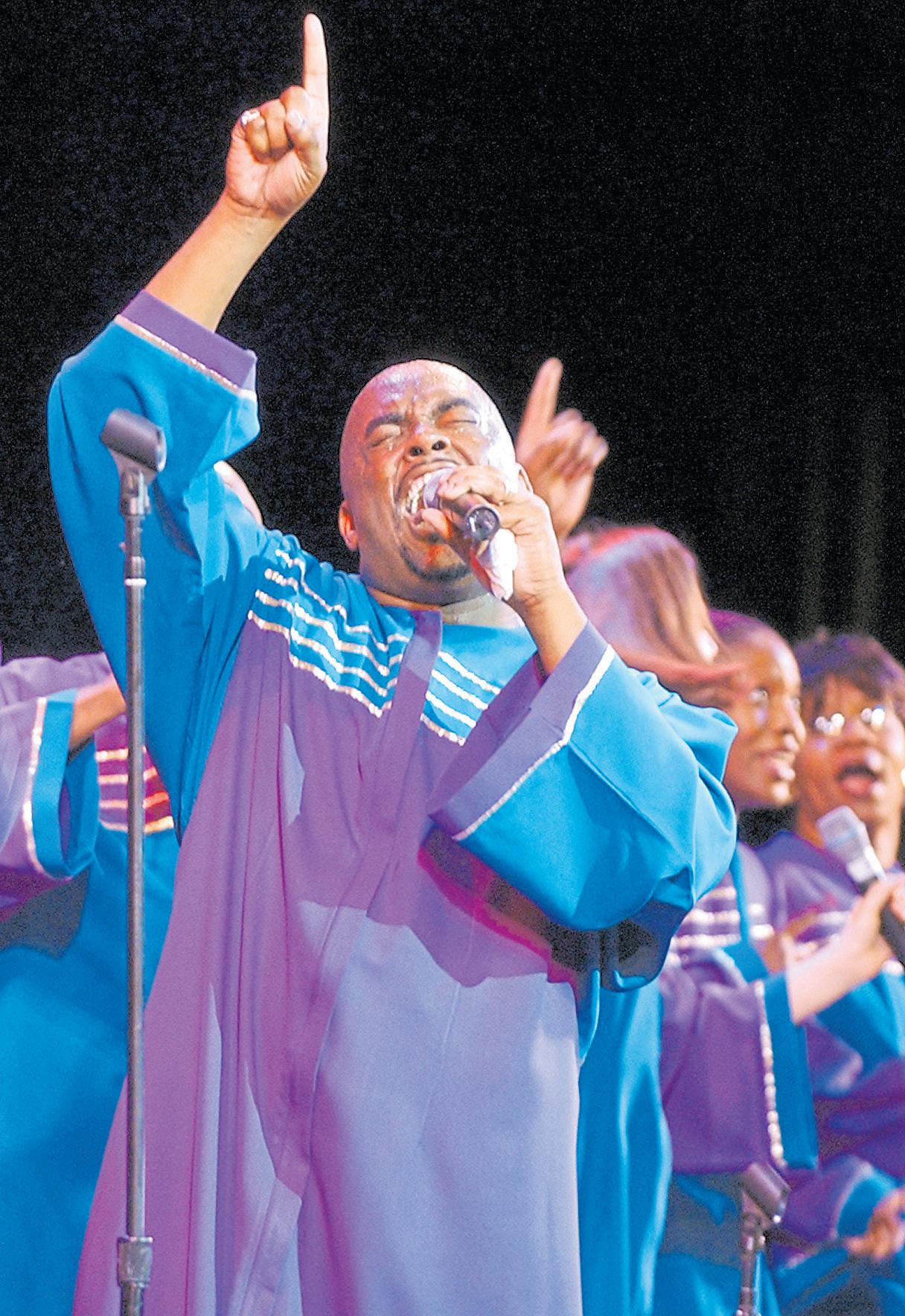
abundant and most certainly include “My Lovin’ (You’re Never Gonna Get It)” and “Free Your Mind” as well as the cover of the Curtis Mayfield-penned Aretha Franklin smash, “Giving Him Something He Can Feel.”
15
“Steppin’ Out,” Gospel Hummingbirds (1992)
The Oakland outfit flies high here, mixing amazing vocal harmonies and uplifting lyrics on such memorable cuts as “That Same Thing” and “He’ll Be Your Friend.” This thoroughly enjoyable album — the first of two released on Blind Pig Records — was nominated for a Grammy award for best traditional soul gospel album in 1993.
16
“All Eyez on Me,” 2Pac (1996)
Tupac Shakur went into Southern California’s Can-Am Studios in late 1995 and emerged with one of the decade’s most important albums. When he unleashed these two discs of powerful West Coast hip-hop in February 1996, the listening public responded in rapturous applause, snatching up more than a half million copies during the first week of release alone. Some seven months after the album’s release, 2Pac was killed in a drive-by shooting.
17
“Lost & Found,” Ledisi (2007)
The Oakland-raised artist’s third album proved to be her breakout effort, reaching the top 10 of the R&B charts and producing a number of popular singles that nicely showcased Ledisi’s soulful vocal work. This sparkling collection of modern R&B tunes
also helped Ledisi earn a 2008 Grammy nomination for best new artist, a category that Amy Winehouse ended up winning (also over Taylor Swift) that year.
18
“Hear My Prayer,” Oakland Interfaith Gospel Choir (2011)
The most acclaimed Bay Area gospel choir of the last 30-plus years has delivered so many top-notch recordings. So, really, just take your pick from the discography. Our choice, however, is this 2011 outing, which finds artistic director Terrance Kelly leading the talented group through one uplifting number after another.
19
“Live at Jazz Standard,” Paula West (2012)
The great Bay Area jazz/cabaret artist delivers an absolute vocal clinic, wowing listeners with her gorgeous work on “Baltimore Oriole,” “Like a Rolling Stone,” “Softly As in a Morning Sunrise” and, perhaps best of all, “Wichita Lineman.” West is supported throughout this winning live set — recorded at the now defunct Jazz Standard club in Manhattan — by the wonderful George Mesterhazy Quartet.
20 “High Maintenance,” Saweetie (2017)
This debut EP ran just 22 minutes, but that was enough to announce to the world that the Bay Area was home to yet another great rapper — Saweetie. The Santa Clara hip-hop star is absolutely magnetic on the mic, drawing in fans with her equally memorable voice and lyrics.

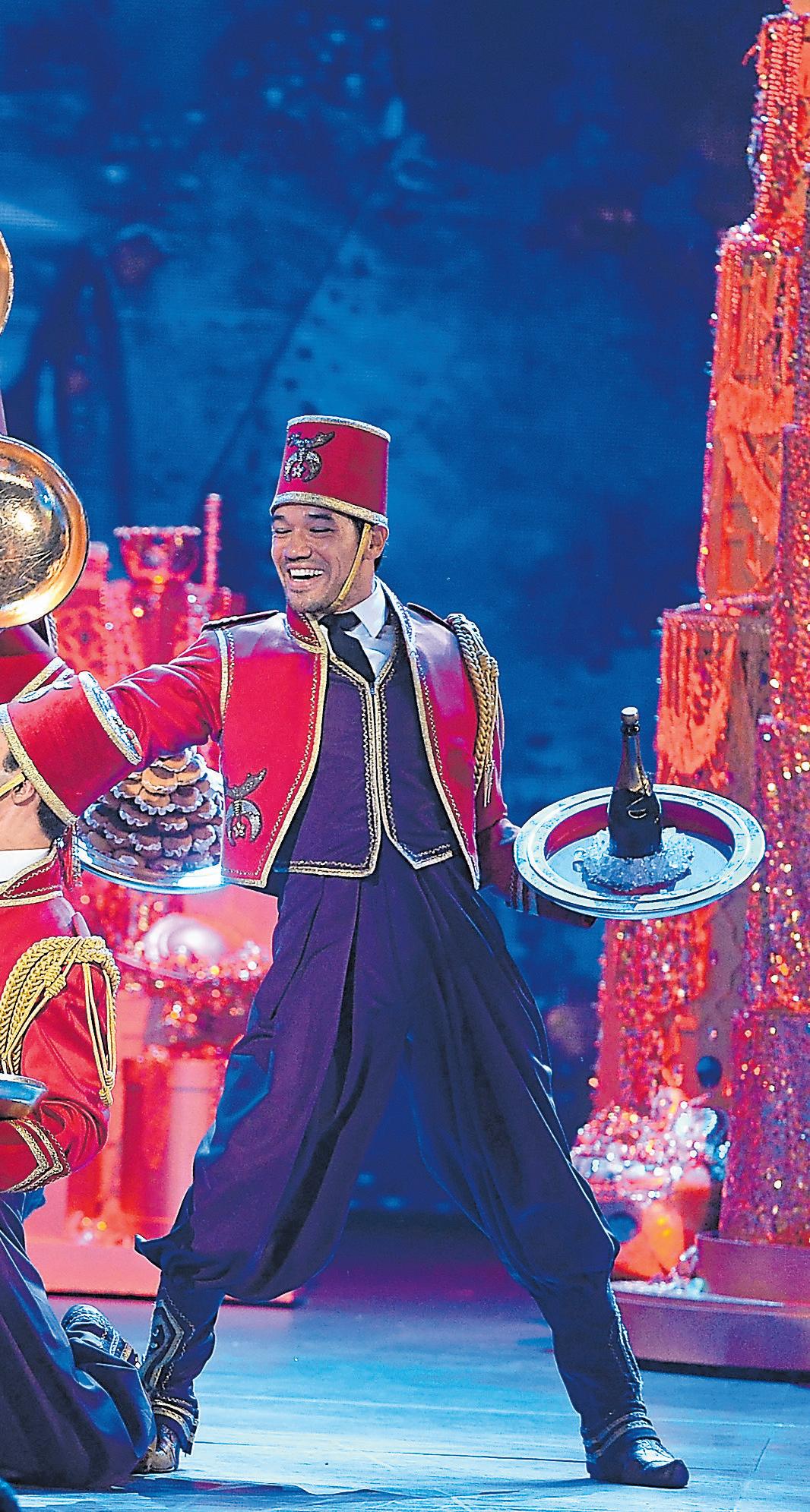
The Broadway theater scene is packed with players who got their start hereBY SAM HURWITT
The Bay Area is one of the great theater hubs of the nation, a breeding ground for new work and for the stars of tomorrow, so it’s no surprise that the road to Broadway for countless performers starts in the Bay.
Musical legend Carol Channing grew up in the Bay Area, after all, graduating from San Francisco’s Lowell High School in 1938 before winning Broadway fame in “Gentlemen Prefer Blondes” and her Tony award-winning turn in the original “Hello Dolly!”
Last year’s “Camelot” revival on Broadway featured Oakland native and former Berkeley Shakespeare Festival artistic director Dakin Matthews as Merlyn, as well as longtime San Francisco actor Marilee Talkington as Morgan Le Fey.
San Francisco native B.D. Wong, who starred in “Big Data” at ACT earlier this winter, won a Tony for “M. Butterfly” in his Broadway debut. Fellow San Franciscan Francis Jue got his start in “Pacific Overtures” at TheatreWorks Silicon Valley in 1988 and later performed in the same show on Broadway, as well as “M. Butterfly” and “Thoroughly Modern Millie.”
Bay Area native Taylor Iman Jones just finished a year-long Broadway stint as Catherine
Parr in “Six.” Berkeley High grad Ar’iel Stachel won a Tony for his role in “The Band’s Visit,” an experience he discussed in his recent solo show, “Out of Character,” at Berkeley Rep.
And Bryce Pinkham, the Tony-nominated star of “A Gentleman’s Guide to Love and Murder,” grew up in Lafayette, his destiny set in motion at the age of ... 6?
“My parents had a parent-teacher conference with my first-grade teacher, who said, ‘I need you to find your son an outlet for his reckless creativity,’” Pinkham says.
So his parents enrolled him in theater camp at Diablo Valley College, where he was cast in the children’s ensemble of DVC’s production of “The Music Man.” When his father, David, came in to talk to the director about a planned family vacation, the elder Pinkham wound up cast in the show as well.
Meanwhile, Bryce Pinkham kept acting as one of many hobbies, but didn’t take it seriously until midway through college at Boston University. In grad school at Yale’s School of Drama, he auditioned for an early reading of “Bloody Bloody Andrew Jackson” and didn’t land it, but director Alex Timbers cast him in another play fresh out of grad school.
But if Pinkham thought it was all going to be that easy, auditioning in New York City soon disabused him of that notion.
“I got an apartment with two friends, and I was running around to three different parttime jobs,” Pinkham says. “I was a waiter, I was a private English tutor, and I was a kids’ soccer coach. And then I ended up booking the New York premiere of ‘Bloody Bloody Andrew Jackson,’ which would eventually go on to be my Broadway debut.”
That was the first of several



Broadway shows, but it was his star turn in “Gentleman’s Guide” that really put Pinkham on the map. Most recently he’s been performing in the hit off-Broadway revival of “Little Shop of Horrors” as the sadistic dentist.
A class Pinkham taught last year at Boston University was titled “Reckless Creativity,” and one thing he tells students is to take a business course.
“I thought I was getting away with something by going into the arts and doing something that was playful and athletic,” Pinkham says. “What I quickly realized is this a business like any other, and I’m the CEO of my own startup. It’s called show business. It’s not called ‘show fun’ or ‘show everybody-gets-achance.’”
Starring alongside Pinkham in “Little Shop” was San Francisco native Darren Criss of “Glee” fame, who got his start in ACT’s Young Conservatory and starred on Broadway in “How to Succeed in Business Without Really Trying” and “Hedwig and the Angry Inch.”
Clearly, there’s something about “Little Shop” — and it’s not just the appeal of Seymour and the Audreys, carnivorous and otherwise. The show is a magnet for Bay Area-bred singers.
Earlier in the “Little Shop” run, before Pinkham and Criss joined the cast, S.F.-born Lena Hall played Audrey (the woman, not the plant), and her Seymour was Matt Doyle, a graduate of Larkspur’s Redwood High School. Both are Tony Award winners. Hall won for her role as Yizhak in the 2014 “Hedwig” revival, and Doyle won in 2022 for the gender-swapped revival of “Company.” In that same
Bay Area native Taylor Iman Jones just finished a year-long Broadway stint as Catherine Parr in “Six.”
ANTONIO PEREZ/CHICAGO TRIBUNETop: Lisa O’Hare, Bryce Pinkham and Lauren Worsham of “A Gentleman’s Guide To Love and Murder” perform during the 68th Annual Tony Awards at New York City’s Radio City Music Hall in 2014. Pinkham, who was nominated for a Tony for his role, grew up in Lafayette.
THEO WARGO/ GETTY IMAGES FOR TONY AWARDS PRODUCTIONS
“Company” was San Mateo-born Bobby Conte, who’s currently back on Broadway as Cousin Kevin in “The Who’s Tommy.”
There might be something about “Aladdin” and its magic carpet ride, too. Half Moon Bay siblings Adam and Arielle Jacobs both starred in that Broadway production at different times. Adam originated the title role and took it on tour, while Arielle joined the Broadway cast as Princess Jasmine. Adam also had star turns in “The Lion King” and “Les Miserables,” and Arielle recently starred as Imelda Marcos in “Here Lies Love.”
When he brought “Aladdin” to the Orpheum in 2017, Adam Jacobs had some advice for theater kids with Broadway dreams: “I always tell kids, don’t forget that passion, because a lot of it’s just perseverance and determination and sticking with it.”
Bottom: Matt Doyle joins the celebration at the 75th Annual Tony Awards held at New York City’s Radio City Music Hall on June 12, 2022.
From the outside, the Bay to Broadway trajectory may look straightforward, but Adam said, “I worked my way up with regional gigs and cruise ships and theme parks and got as much experience as I could. Try to come to New York or L.A. with a little bit of experience instead of jumping straight in, and then don’t let anybody take that passion away from you.”
Hayward native James Monroe Iglehart won a Tony for his role as the Genie in that same original “Aladdin” cast. This year Iglehart has back-to-back Broadway stints as King Arthur in “Spamalot” and Louis Armstrong in “A Wonderful World” this fall.
The current Jasmine in “Aladdin” is Sonya Balsara, who grew up in El Cerrito and Berkeley. She’s played Jasmine since January of 2023 after a two-month stint in mid-2022, just a few months after she performed in TheatreWorks’ “Sense and Sensibility” musical. This starring role was her Broadway debut.
“I saw a production of ‘Okla-

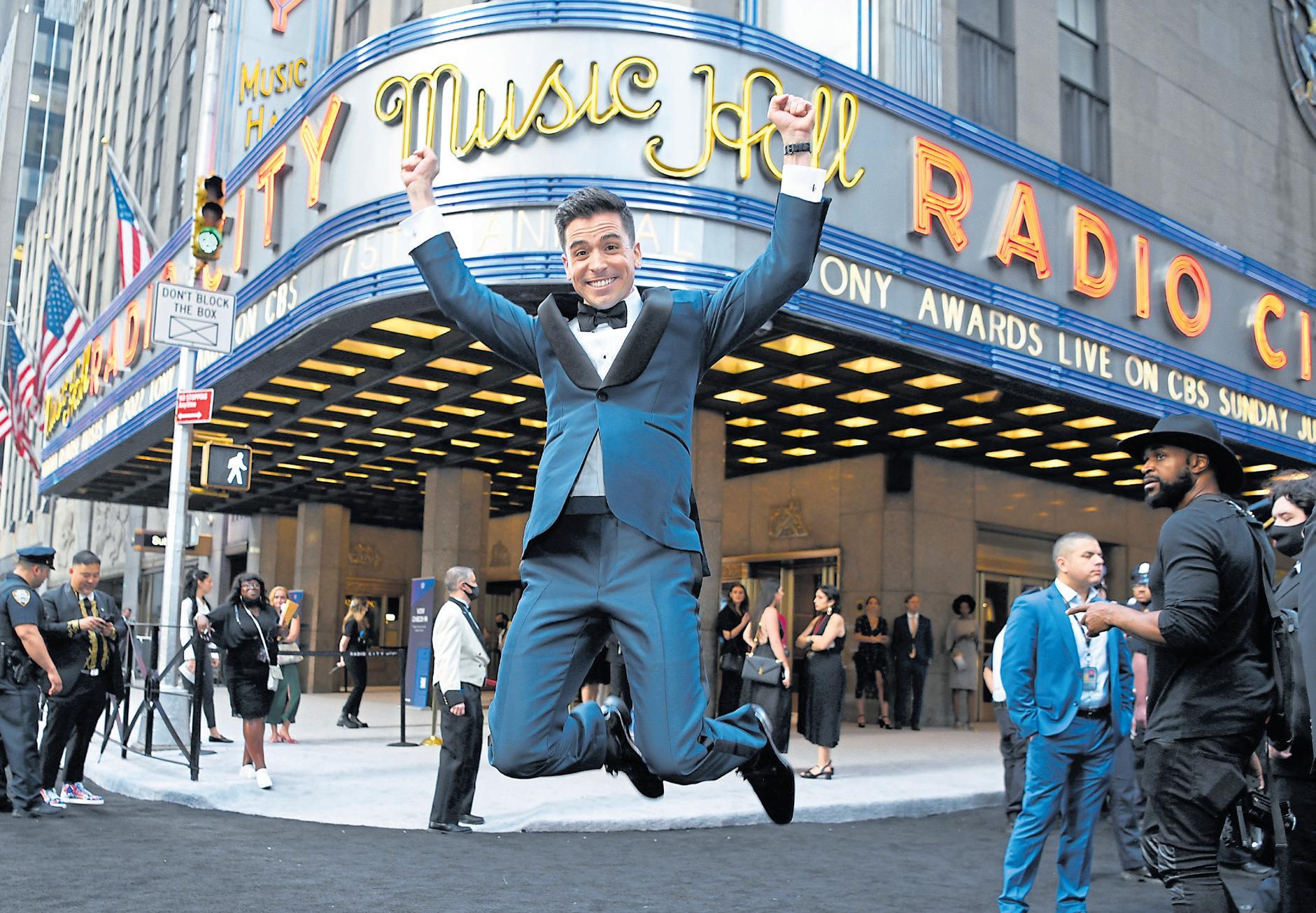

homa’ at Albany High School in fourth grade, and it changed everything,” Balsara recalls. “I went to Silver Screen Video in El Cerrito Plaza and rented the movie and wrote out a whole script of ‘Oklahoma.’ I held auditions at my elementary school and cast it and then put it on in my living room.”
Having grown up doing children’s theater with Contra Costa Civic Theatre and other companies, Balsara went from Berkeley High to New York University, where she was cast in her first feature film while still in college.
“I worked as a legal assistant and booked a few short film and TV things and a lot of commercials,” Balsara says. “But it took about a year and a half until I booked my first professional theater job, which was ‘West Side Story’ in Tokyo. I played Maria. Getting that job really catapulted my career.”
Appropriately enough for a Disney princess, Balsara accentuates the positive in her advice for Broadway hopefuls.
“Kindness goes such a long way in this industry, and people remember that about you, if you’re easy to work with,” Balsara says. “Everyone’s really, really talented, and the thing that’s going to set you apart is really knowing who you are, being your authentic self and being kind. And also knowing that your success is not a reflection of your talent and ability and even your hard work. A lot of the time your success is about luck, and you have to be patient and kind to yourself about it, too.”
Still on the road to Broadway is Fremont’s Shefali Deshpande, who plays Mrs. Darling in the national tour of “Peter Pan” that will come to Broadway San Jose this June.
It’s an adaptation of the 1954 musical newly revised by playwright Larissa FastHorse. Playing young John is another Bay Area native, William Foon,
who has performed locally with Walnut Creek’s Center Rep and Lafayette’s Peter Pan Foundation.
“I’ve been singing and dancing since I was a little kid,” Deshpande says. “I did tap and jazz, I did some ballet, I did Indian classical dance and Hindi film dance. When I was 12, there was a community theater production of ‘Peter Pan.’ It was the first musical I ever did, which feels like a crazy full-circle situation now.”
Deshpande graduated from the University of Southern California with a degree in political science and a minor in musical theater. In L.A., she initially focused on screen work and releasing her own original R&B music before returning to musical theater in 2021 as Kamala Harris in the touring Capitol Comedy musical, “Biden My Time.”
“It is a marathon, not a sprint,” Deshpande says. “You will watch people you were in class with skyrocket, and all you can do is be happy for them, because everybody’s timing is different. That phrase, ‘comparison is the thief of joy,’ could not be more true. What it takes is perseverance, hard work and focusing on what it is you want and then not stopping until you get it.”
So Deshpande’s advice for the next generation of performers is to stick with it and not be deterred when things don’t work out at first.
“In this industry, there are no guarantees,” Deshpande adds. “I could still be auditioning 10 years from now and never have landed anything that felt like a big break. But that’s what you sign up for, because the reward is so high. When a little girl comes up to you after the show and says, ‘Oh my gosh, that was amazing!’ and she’s inspired to go back to her school and do plays — that’s the biggest reward.”
Leslie Noel Hansen was just 25 and flourishing amid the Bay Area’s music scene in 2006, teaching singing lessons, dreaming of Broadway and preparing to head to New York.
That all changed the day she learned that Steffen Ryge, one of the Lafayette teens Noel Hansen had taught, had died in a car accident. The Acalanes High senior had starred as Peter Pan in Noel Hansen’s original “Wish Upon a Star” musical, staged by local teens who donated the weekend’s proceeds, some $20,000, to Oakland’s UCSF Benioff Children’s Hospital.
“It was a very whimsical, collaborative, fun project with me and a bunch of teens who wanted to do something special,” she says.
The troupe went on to perform the show for young patients at the hospital and had planned to stage another performance before Ryge left for college. That day never came.
At the time, Noel Hansen was set to play Christine in a touring production of Broadway’s “Phantom of the Opera,” after training with Franc D’Ambrosio, who played the Phantom in the Tony award-winning musical for more than six years. Booked to per-
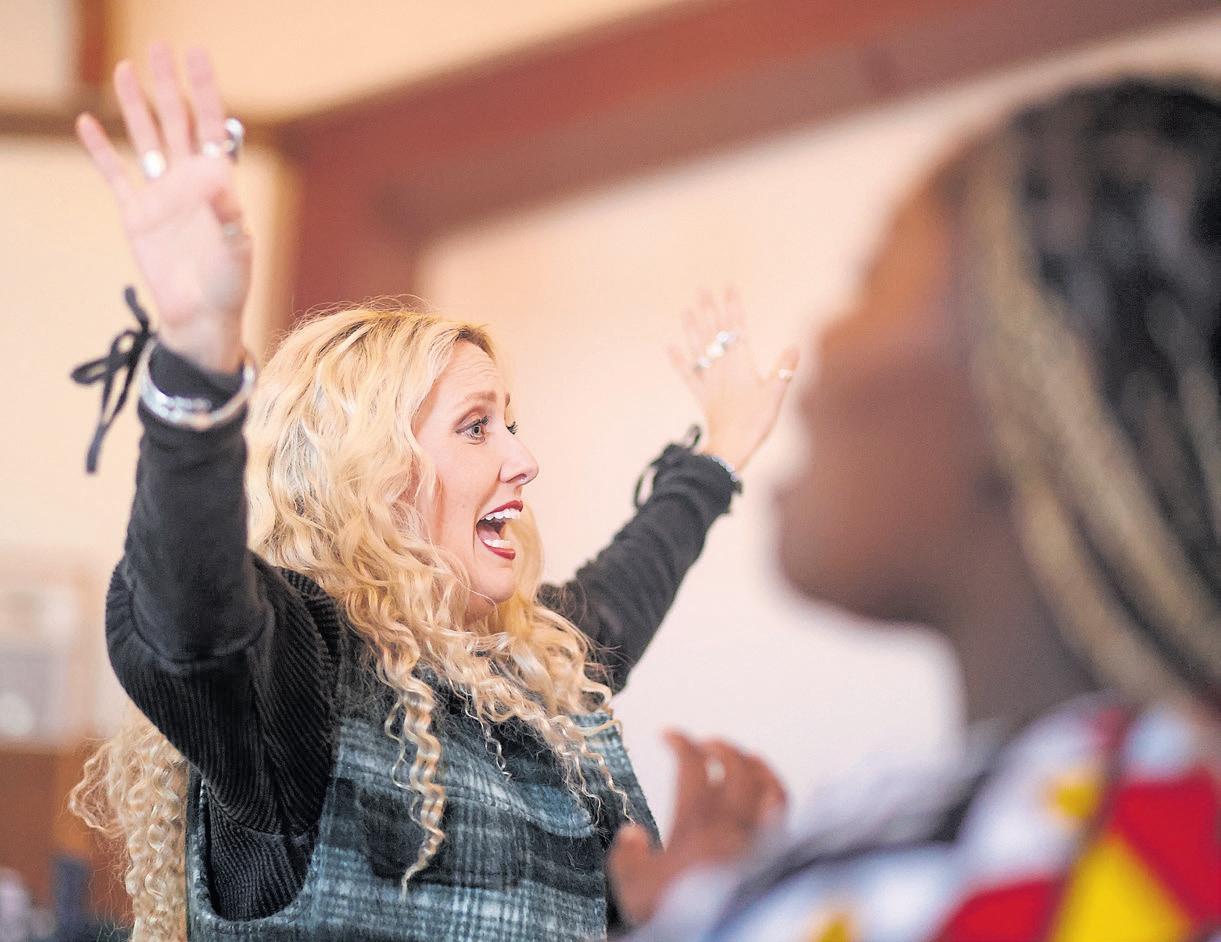
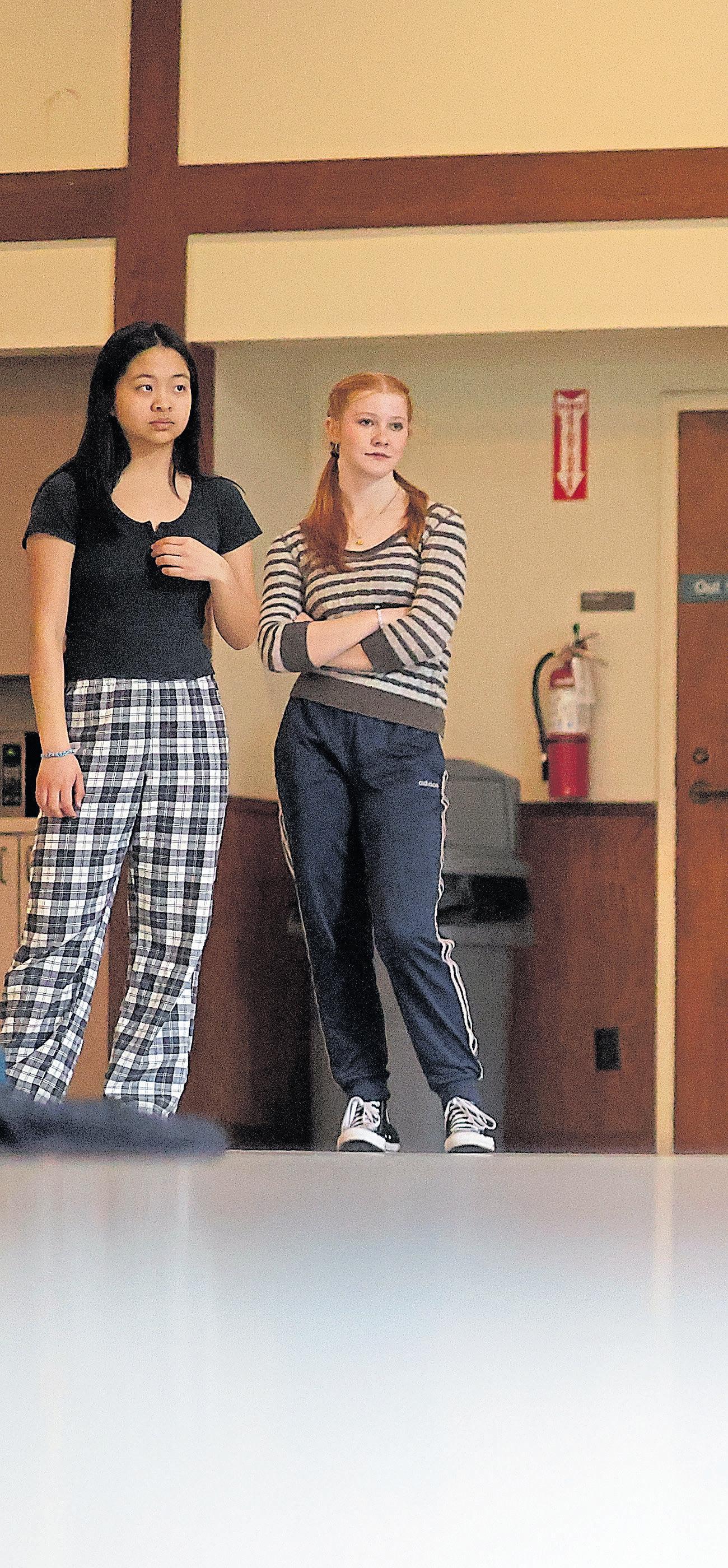
form at Ryge’s memorial service and open for D’Ambrosio in a concert the same day, the distraught Noel Hansen realized she couldn’t leave this community.
So she launched the Peter Pan Foundation, which offers mentoring, performance and philanthropic opportunities and inspiration for young musicians and actors, a new generation of Peter Pans.
“There are people that need music for so much more than entertainment,” she says. “They need it for hope, health and joy. I want to show kids they can be world changers through their gifts.”
She’d seen the power of those hospital performances for the young patients, certainly, but also for the singers, who bring joy and hope, as they give back.
“There are people that need music for so much more than entertainment. They need it for hope, health and joy. I want to show kids they can be world changers through their gifts.”
Leslie Noel Hansen
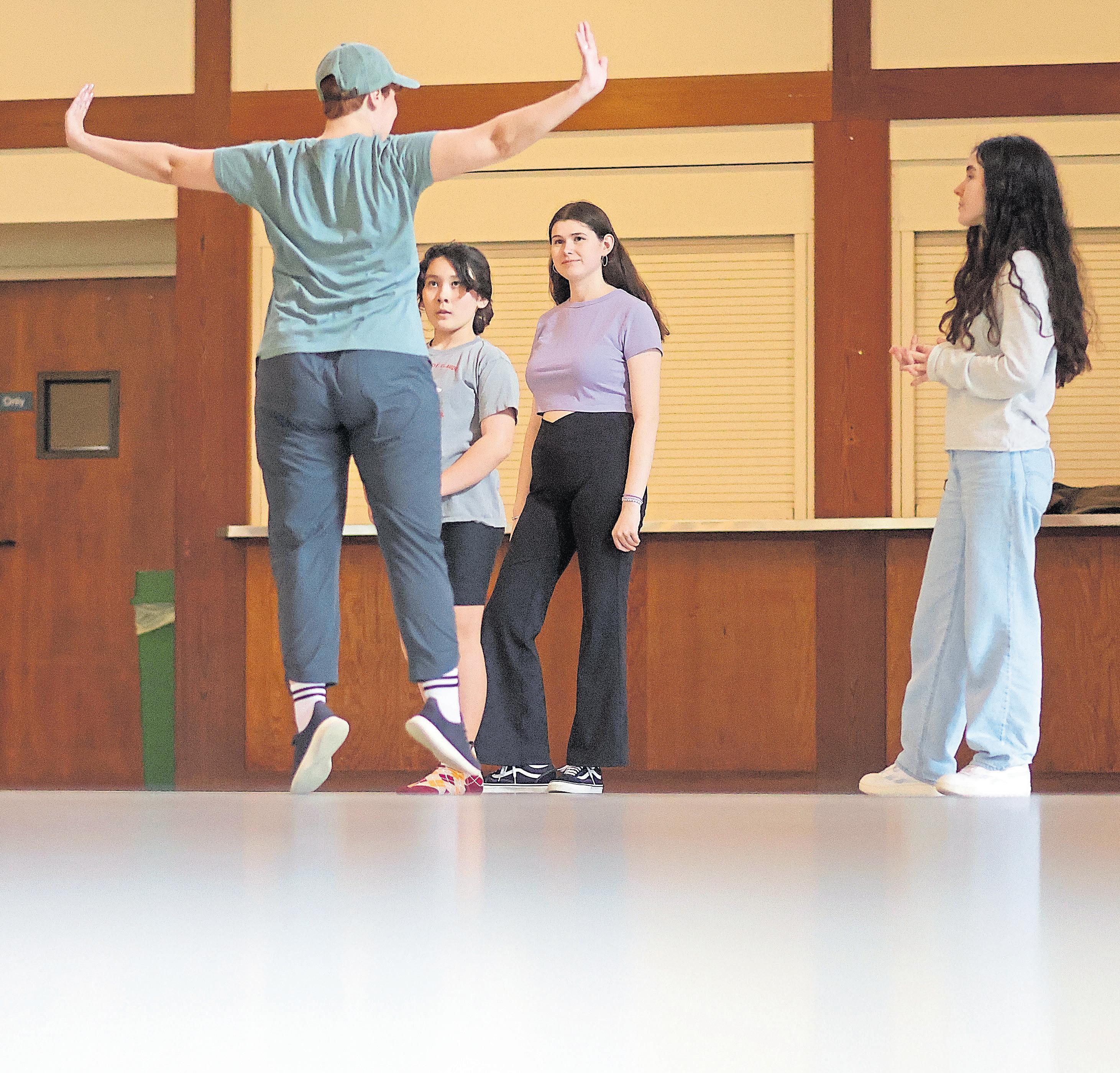
Noel Hansen had been a young patient herself, struck with the sudden paralysis of Guillain-Barre syndrome when she was 17. It was a scary time, she recalls. At one point, doctors expressed surprise that the paralysis hadn’t spread to her lungs, which had been strengthened by years of music training. They told her that singing had probably saved her life. The memory stayed with her: If singing had saved her life, then maybe it could help other young people in powerful ways, too.
More than two decades later, musical kids of all ages still gather to rehearse, brainstorm and hang out at “The Treehouse,” the nonprofit’s Lafayette
home. They give annual benefit performances of “Wish Upon a Star,” volunteer as hospital visitors and performers, sing in monthly open mic cabaret nights and participate in the teen leadership council dubbed the Bay Area Magic Makers.
The program’s magic has helped a new generation of performers and leaders take flight literally and figuratively. Take William Foon, an Orinda 12 year old, who is performing as young John Darling in the Broadway touring production of “Peter Pan,” which lands at San Jose’s Center for the Performing Arts in June.
The Peter Pan Foundation helped familiarize William with

the audition process, says his mother, Jiin Son, while providing a theater atmosphere that is inclusive rather than competitive. William has worked with a wide array of East Bay theater, dance and music programs, she says, but as he performs at venues around the country, it’s the foundation’s cabaret nights that he misses most.
The organization’s inclusivity is apparent in its casting of performers of different ages, ethnicities, gender identities and abilities, including Noelle Wilder, a deaf performer who provides American Sign Language interpretations for foundation shows.
“I’ve been placed in unique spotlight positions, where I can highlight the beauty of American Sign Language alongside the beautiful voices of the Peter Pan Foundation,” Wilder says. “I’ve been able to be different Disney characters while still including and acknowledging my deaf identity.”
And for Justin Campo, who joined the foundation a decade ago, when the then-12 year old’s cancer went into remission, the foundation has offered a way to share the joy that others brought him during his hospital stays.
“I’d been visited by characters and got to see shows in the hospital,” he says, “and only a few years later, I was going — dressed as princes, Peter Pan and superheroes.”
Today, he uses the leadership and people skills he learned through the foundation at school, at work and in his relationships. What keeps him coming back even as an adult, he says, is that “we don’t just put on shows. It feels familial.”
Campo will play Peter Pan in this year’s “Wish Upon a Star,” which hits the stage Memorial Day weekend with a music lineup that includes songs from Disney’s 2023 “Wish.”
“It’s an accumulation of every single Disney character and song you know and love,” Campo says. “It’s just a warm hug of a show.”
Have you got a desire for choir? A penchant for pitch or a hankering for harmony? The Bay Area brims with scores of chorales of every variety, from WomenSing to Schola Cantorum, the Choral Group and more. Whether you’re a singer yourself or just looking for a musical night out, here’s a sampling of ensembles to explore.
This Milpitas-based chapter of Sweet Adelines International has been an a cappella mainstay since 1956, performing everything from barbershop bops to contemporary songs, all arranged in close, four-part harmony. The local chapter currently has 50 members, but they’re always looking for more, regardless of age, vocal range or musical background. Join them on the risers or find details on upcoming shows at singharmony.org/
This non-audition community ensemble, founded in 1966 under the auspices of the Berkeley Adult Education Program, offers free concerts and performance opportunities for emerging singers and musicians. The BCCO is quite popular though, so you’ll have to join the waiting list before you can take the stage. Meanwhile, mark your calendar for June 7-9, when the ensemble performs Ernest Bloch’s “Avodath Hakodesh”; bcco.org.
Formed in 1966 as the Richmond Symphony Chorus, this non-audition

group sees choral singing as a community builder, hosting fundraisers to support local music programs, providing equal footing in programming and performing music specific to minority representation. Their spring concert, “Make Our Garden Grow,” on May 11-12 will showcase works written by Black, women, Indigenous and LGBTQ+ composers. ccchorale.org/
This Pleasant Hill-based ensemble is one of the East Bay’s longest-running secular chorales, founded in 1942 to aid the war effort and raise morale. Their modern aim is to spread joy and light through an uplifting contemporary repertoire of pop, jazz, and folk idioms. Auditions are held twice a year, and the group welcomes women, female-identified, non-binary and gender-fluid singers with varying musical backgrounds. If you’re too shy
The Ragazzi Boys Chorus performs at venues around the Bay, including this concert in San Mateo, which marked the ensemble’s 35th anniversary.
to take the stage, sit back and enjoy the show. Their next performance is ‘“A Lovely Way to Spend an Evening” on May 18-19; diablowomenschorale.org/.
Originally established as the Ohlone Chamber Singers in the 1980s, Fremont’s Mission Peak became an independent nonprofit in 2014, after California community colleges withdrew support for choral arts. They’ve been on a mission to reach and inspire new audiences ever since, an effort that included the launch of an East Bay People’s Choir in 2018. While Mission Peak Chamber singers go through an audition process, the East Bay People’s Choir is open to all, and everything is performed by ear, no music reading necessary. If Peak has you piqued, head for their next concert, “Illluminare,” on May 18; chambersingers.org/concerts.
Founded in 1980, the Berkeley-based Pacific Edge chorus performs a diverse repertoire of choral and a cappella music. PEV highlights include a Carnegie Hall debut, four international tours and a 2006 Grammy Award nomination. It sounds fancy, yes, but you don’t have to be a professional singer to get in on the action. Whether you’re classically trained or just like singing in the shower and belting out Lizzo and “Hamilton,” PEV invites all to audition. Their next concert, “PEV Presents: A Cappella, Jazz & Pop” will be June 8; pacificedgevoices.org/.
This a cappella men’s barbershop chorus was originally chartered in 1948 by the Society for the Preservation and Encouragement of Barbershop Quartet Singing in America. The group began in San Carlos but has since migrated to Redwood City, Palo Alto and now, Sunnyvale, hence the group’s name. The group is always looking for new, enthusiastic music lovers to join them for four-part harmonies. Sit in on an open rehearsal or check the calendar for upcoming concerts at thepeninsulaires. com/.
Founded in 1987, this Silicon Valley ensemble is the Bay Area’s largest boys chorus with more than 200 members. The Grammy award-winning chorus is stellar on its own in concert as well as in performances with the San Francisco Opera, San Francisco Symphony and Opera San Jose. Ragazzi has performed in historic venues such as Carnegie Hall and will make its Sydney Opera House debut in July. Closer to home, you can hear Ragazzi’s Young Men’s Ensemble perform at “Siblings in Song” on May 5; https://ragazzi.org/.
Opposite: Post Malone belts out a song for the crowd at BottleRock Napa Valley in 2023.
CHRIS RILEY/STAFF
Whether you’re looking for outdoorsy weekend fun, day trip adventures or the latest restaurant news, these free newsletters offer plenty of inspiration. Take a peek below, then sign up at mercurynews.com/newsletters or eastbaytimes.com/newsletters
Find inspiration for West Coast road trips, weekend getaways and close-to-home fun here every Monday morning. apps.mercurynews.com/newsletters/travel-play
Your Bay Area guide to what to do this weekend — hikes, shows, festivals and more — arrives every Thursday morning. apps.mercurynews.com/newsletters/weekender
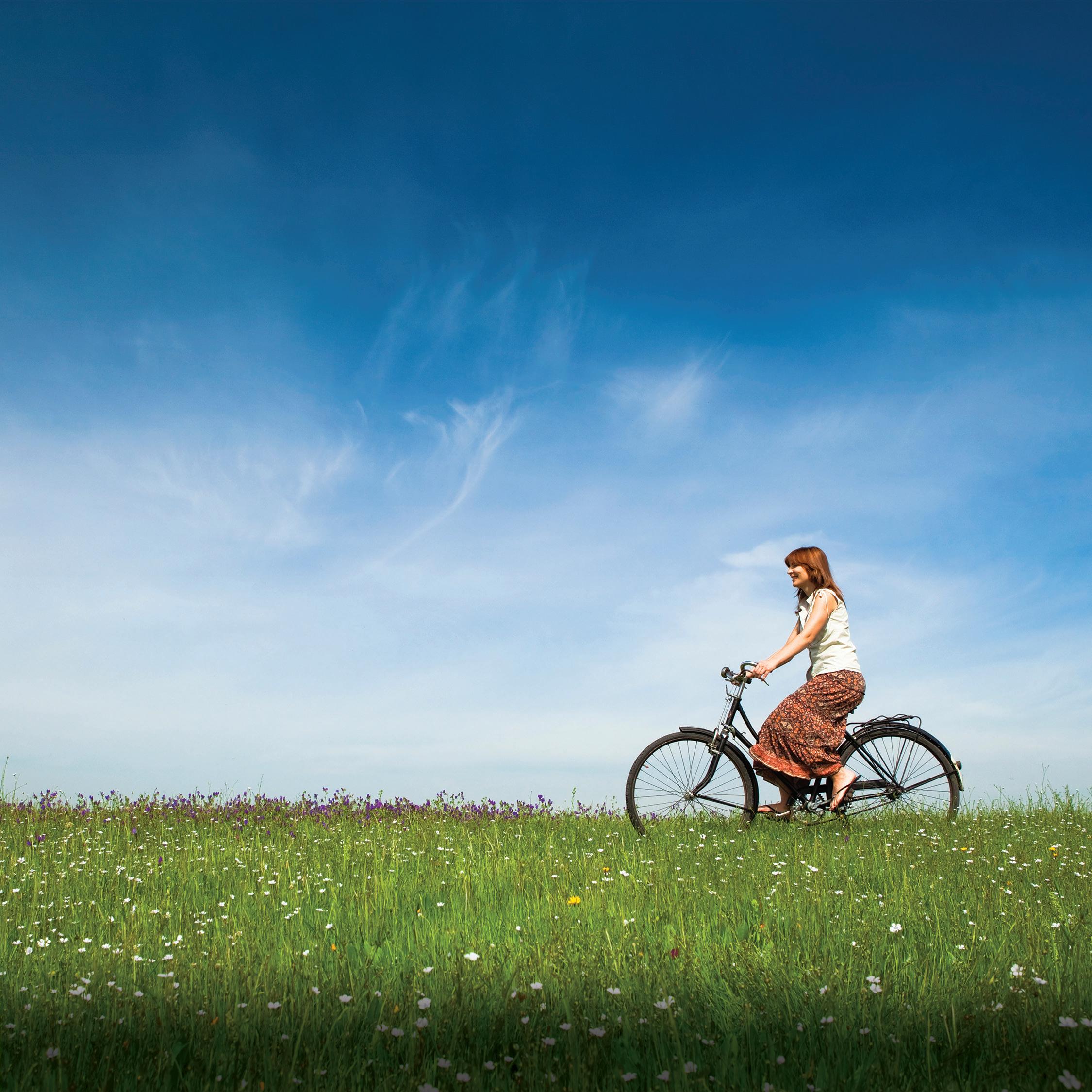
Buzzy new restaurant openings, taproom updates and delicious recipe inspiration fill this free weekday newsletter. apps.mercurynews.com/newsletters/eat-drink